Why Super Nintendos Lose Their Color: Plastic Discoloration in Classic Machines
January 12th, 2007 by Benj Edwards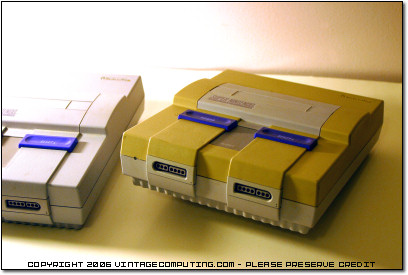
Sure, consoles age and get dirty. Heck, I remember a suspicious incident involving my Super Nintendo (SNES) console and a can of Coca-Cola in the early ’90s that left my SNES looking more like a moldy loaf of bread than a video game system. But around five years ago, I noticed that my SNES console was aging particularly badly. I cleaned off all the remnants of fossilized Coke residue from the chassis with a wet washcloth, but the “moldy bread” look still remained. The top half of the console’s plastic body retained a uniformly nasty yellow-brown hue, while the bottom half flaunted its showroom shine — that native SNES gray that we all know and love. I soon realized that a much deeper mechanism was responsible for the aesthetic disfigurement of my beloved SNES than mere dirt and sugar.
To further complicate matters, I have another SNES unit that was obviously produced more recently than my original one, and that console shows no sign of aging whatsoever. Comparing the units and the way different parts of them had discolored led me to believe that there is something different about the two batches of plastics — the one for the top half of the SNES chassis and the one for the bottom, or the plastic for the old unit and plastic for the new — that made them age differently over time.
Immediately below are two photos I took of my actual SNES units. Notice the difference between the colors of the top and bottom halves of the plastic chassis on the older unit, and also how the newer unit shows no sign of discoloration at all.
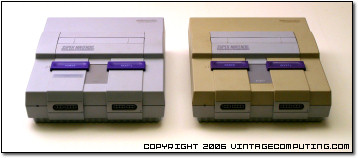 My first SNES console (right) exhibits discoloration on the top half only.
My first SNES console (right) exhibits discoloration on the top half only.
The newer unit on the left, however, looks as good as new.
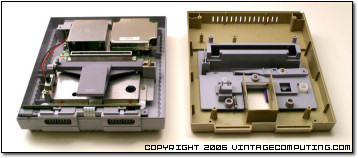 The top half and bottom half of my first SNES console, disassembled.
The top half and bottom half of my first SNES console, disassembled.
Notice that the underside is yellowed with the same uniformity as the top.
The Investigation Begins
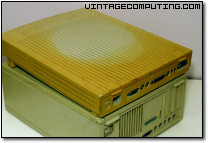 Case yellowing effects aren’t limited to the Super Nintendo console. Many models of Apple Macintosh computers exhibit similar symptoms: their cases discolor heavily as they age, frustrating computer collectors everywhere. I had long heard that plastic discoloration had something to do with UV exposure, which made more sense for the Macs, but not so for the SNES. In the case of the SNES itself, the chassis was uniformly discolored on both the outside and the inside of the case, which means that it could not have been the work of light. With all this in mind, I set out to find what was causing these plastic yellowing effects, and if the yellowing on the SNES and the Macintosh cases were related.
Case yellowing effects aren’t limited to the Super Nintendo console. Many models of Apple Macintosh computers exhibit similar symptoms: their cases discolor heavily as they age, frustrating computer collectors everywhere. I had long heard that plastic discoloration had something to do with UV exposure, which made more sense for the Macs, but not so for the SNES. In the case of the SNES itself, the chassis was uniformly discolored on both the outside and the inside of the case, which means that it could not have been the work of light. With all this in mind, I set out to find what was causing these plastic yellowing effects, and if the yellowing on the SNES and the Macintosh cases were related.
After poking around the net, I found some forum threads where people seemed to have vague ideas about what was causing the yellowing. Suggestions and accusations from forum regulars like “Wash your hands!” or “It’s tobacco stains,” were usually returned with, “But I’m a clean guy!” and “I don’t smoke,” so the problem isn’t quite that simple. Other people weighing in on the issue seemed more knowledgeable and suggested that keeping computers away from windows and fluorescent lighting will help prevent discoloration. Sounds good to me, but why, exactly, would sunlight cause certain plastic to yellow while other plastics retained their original color?
While searching the forums, the most helpful hint I found regarding the SNES was this. Someone had asked Nintendo of America’s customer support about the issue, and this is how they responded:
Message(#6851-000101-5635\1015635)Hi!
Thank you for contacting us. That’s an interesting question! For the Super NES, this is a normal condition and no cause for alarm. Cleaning or handling the system will have minimal impact to change or revive the original color.
The Super NES, as well as our other systems, are made with a plastic containing flame-retardant chemicals to meet safety guidelines. Over time, the plastic will age and discolor both because of these chemicals as well as from the normal heat generated from the product or exposure to light. Because of the light color of the plastic of the SNES and NES, this discoloration is more easily seen than with other darker plastics such as on the N64 and the Nintendo GameCube.
Thanks for your email!
Nintendo of America Inc.
Casey LudwigNintendo’s home page: http://www.nintendo.com/
Power Line (Automated Product Info): (425) 885-7529
Sounds pretty good to me, but is it true? While trying to get a more specific answer, I decided to write NOA myself to see what they said. This is what they responded:
Thanks for the e-mail. Unfortunately I don’t have an answer to your question. We’ve stopped servicing the Super NES many years ago, so our information is limited. I took a look at what we have, and nothing discusses housing discoloration. In addition I don’t have anyone I could refer you to that would be able to answer that question. If you need additional assistance, please contact our Consumer Service Department by calling 1-800-255-3700. Our representatives are available between 6:00 a.m. and 7:00 p.m. Pacific Time, seven days a week.
Sincerely,
Nintendo of America Inc.
Shane O’Neil
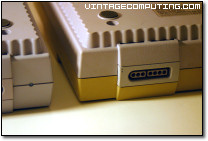 As you can read, the answer they sent me wasn’t nearly as helpful as the forum patron’s response. The only thing I learned from their reply is that people must not ask NOA support questions about discoloration very often if they don’t have a prepared answer for it.
As you can read, the answer they sent me wasn’t nearly as helpful as the forum patron’s response. The only thing I learned from their reply is that people must not ask NOA support questions about discoloration very often if they don’t have a prepared answer for it.
[ Update: 01/17/2007 – Long ago, I tried to contact Nintendo of America’s PR Department about the plastic discoloration so I could get an official comment. This is the final reply I got from NOA today: “Sorry it has taken me a while to reply but I was unable to track someone down who could talk about the plastics chosen for the various Nintendo systems. The systems are shipped to the U.S. after they are assembled so it is decided out of the Nintendo corporate office in Japan.” Indeed, it is hard to track down the Japanese Super Nintendo plastics engineers who most likely didn’t even work directly for Nintendo. ]
When in Doubt, Consult an Expert
 Unsatisfied with Nintendo’s answer, I decided to dig deeper. I contacted Dr. Rudolph D. Deanin, founder of the graduate program in Plastics Engineering at the University of Massachusetts, Lowell and director of the program for over thirty years. I told him everything I know about plastic chassis discoloration in both the Super Nintendo and Macintosh computers and asked what he thought might be causing it.
Unsatisfied with Nintendo’s answer, I decided to dig deeper. I contacted Dr. Rudolph D. Deanin, founder of the graduate program in Plastics Engineering at the University of Massachusetts, Lowell and director of the program for over thirty years. I told him everything I know about plastic chassis discoloration in both the Super Nintendo and Macintosh computers and asked what he thought might be causing it.
“The plastics most commonly used to make the structural cases for electronic equipment are polypropylene, impact styrene, and ABS,” replied Deanin. “These all tend to discolor and embrittle gradually when exposed to UV and/or heat. They become oxidized and develop conjugated unsaturation, which produces color. They crosslink or degrade, which causes brittleness.”
From looking at a stamp on the Super Nintendo’s plastic case, I learned that the case is composed of ABS, which is a rugged, durable plastic that is sadly more susceptible to discoloration and degradation from both UV and heat than the alternatives.
“There are other plastics which would be more stable,” Deanin continued, “but manufacturers avoid them because they are more expensive and/or more difficult to process.”
Instead of using more expensive plastics, manufactures put additives known as stabilizers, absorbers, or blockers into the plastic mixture to reduce the effects of degradation. They also get creative with their use of pigmentation.
“Since most discoloration is toward yellowing, some manufacturers add a little blue to neutralize the yellow,” Deanin said. “This gives a temporary reprieve, but eventually the yellow keeps growing and overpowers it anyway.”
The Best Answer Involves Chemistry
Deanin’s helpful response got me really curious. I wanted to know more about how exactly the whole plastic degradation process works, but he didn’t go into it in detail. For example, what exactly about degradation makes the plastic change color?
After a few days of research on the process though jargon-dense industry white papers and by lurking on plastics forums, I managed to piece together an answer. Unfortunately, most of what I found focused on the UV-degradation (light exposure) side of things, which is most applicable to the discoloration of Macintosh cases. But we can apply some of what we’ll learn to the SNES in a moment.
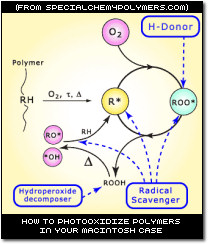 Most plastics typically reflect the majority of UV light that hits them. However, if there are trace elements of catalyst residues (chemicals used in manufacturing of the plastic), such as if the manufacturer doesn’t get the mixture quite right, then the residues present in the final plastic will absorb UV and drastically accelerate the degradation process. Exposure to UV light in this instance starts a process called photodegradation (through photooxidation), which takes place in parallel with thermal oxidation (from exposure to heat). Both processes break down the chemical structure of the plastic as certain parts of it combine with available oxygen. And once this process gets started, it feeds upon itself and starts a continual cycle of degradation. Interestingly enough, the disrupted plastic molecules that are produced by the photooxidation process absorb UV light themselves and re-emit it at a lower wavelength (in the visible range), which changes the perceived color of the plastic.
Most plastics typically reflect the majority of UV light that hits them. However, if there are trace elements of catalyst residues (chemicals used in manufacturing of the plastic), such as if the manufacturer doesn’t get the mixture quite right, then the residues present in the final plastic will absorb UV and drastically accelerate the degradation process. Exposure to UV light in this instance starts a process called photodegradation (through photooxidation), which takes place in parallel with thermal oxidation (from exposure to heat). Both processes break down the chemical structure of the plastic as certain parts of it combine with available oxygen. And once this process gets started, it feeds upon itself and starts a continual cycle of degradation. Interestingly enough, the disrupted plastic molecules that are produced by the photooxidation process absorb UV light themselves and re-emit it at a lower wavelength (in the visible range), which changes the perceived color of the plastic.
In the case of the SNES plastic, however, the trigger of the oxidation process is clearly not UV light, but simple and unavoidable exposure oxygen in the air over time, with heat possibly accelerating the process. Once the process is triggered, its effects cascade in a recursive cycle — as in the UV example above — eventually changing the physical nature of the plastic and its color. Visual proof that exposure to air is causing the SNES discoloration can be seen in the picture below:
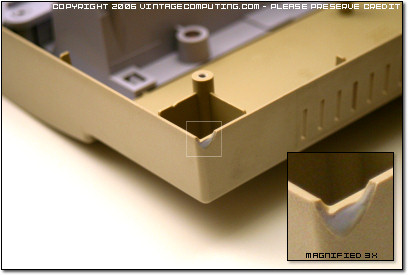 A piece of my Super Nintendo’s case was chipped off accidentally at some point in the console’s recent history. Notice how the center of the case’s plastic — which hasn’t been exposed to air for very long — is still gray.
A piece of my Super Nintendo’s case was chipped off accidentally at some point in the console’s recent history. Notice how the center of the case’s plastic — which hasn’t been exposed to air for very long — is still gray.
In The Name of Retardation
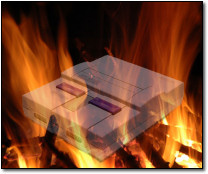 So think back. Those flame retardant chemicals that Nintendo mentioned are starting to sound like a plausible trigger for premature degradation in the SNES. If we presume that those flame retardant additives, if mixed in an improper amount, have a similar effect as the catalyst residues that are absorbing the UV light and heat and triggering the photodegradation process described above, then it could account for the discoloration effect we’ve seen. Deanin weighed in on the flame retardant issue only by saying that most retardants are harmless, but certain “aliphatic bromine compounds” are unstable to heat and UV, and should be avoided. Flame retardants unstable to heat! How ironic.
So think back. Those flame retardant chemicals that Nintendo mentioned are starting to sound like a plausible trigger for premature degradation in the SNES. If we presume that those flame retardant additives, if mixed in an improper amount, have a similar effect as the catalyst residues that are absorbing the UV light and heat and triggering the photodegradation process described above, then it could account for the discoloration effect we’ve seen. Deanin weighed in on the flame retardant issue only by saying that most retardants are harmless, but certain “aliphatic bromine compounds” are unstable to heat and UV, and should be avoided. Flame retardants unstable to heat! How ironic.
So Why the Two-Faced SNES?
Since two different batches of plastics had two different aging results (as illustrated in the top and bottom halves of my SNES, or the old and new SNES units), then there must have been a difference of additives between them. Perhaps in one of the production runs of plastic, they didn’t get the catalyst or flame retardant mixture quite right and more residues were left over in the top half’s plastic batch, thus causing it to degrade more rapidly over time. And by the time Nintendo produced the later runs of Super Nintendos, they had probably fixed the problems in the manufacturing process of their plastic, meaning that those later models aren’t as susceptible to oxidation as the earlier models are.
Some Super Nintendo consoles discolor only on the bottom half, some discolor only on the top half (like mine), and some on both sides evenly. Which side(s) get discolored is based only upon the luck of the draw — that is, which plastic batch was used to create each part of the plastic shell, and which manufacturing run the different halves of the case came from when the consoles were being assembled.
So, What Can I Do About It?
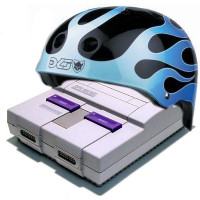 Now that you’ve heard all about plastic discoloration and its causes, you’re probably wondering what you can do to prevent or fix it. Unfortunately, the best answer is, “not much.” The only prevention tip Deanin had for me was this:
Now that you’ve heard all about plastic discoloration and its causes, you’re probably wondering what you can do to prevent or fix it. Unfortunately, the best answer is, “not much.” The only prevention tip Deanin had for me was this:
“A useful way to prevent UV discoloration is to put a UV-resistant plastic coating on top of the base plastic. This adds to the cost, but it definitely solves the problem. ”
Ok, so you can paint your old consoles with a UV-resistant coating, but that might not be a very attractive option to historical purists (if you care about that sort of thing). And applying an even coat without accidentally spraying connector ports, cartridge slots, and other electronics would be difficult without completely disassembling your unit and masking sensitive areas. So what can you do after the discoloration has taken place? Once, again, Deanin couldn’t offer many options.
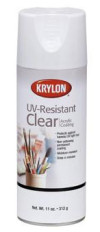 “Paint it! The auto industry paints much of the plastic they use in cars. The paint industry could certainly design an optimum paint formulation for such a market.”
“Paint it! The auto industry paints much of the plastic they use in cars. The paint industry could certainly design an optimum paint formulation for such a market.”
So, yeah, you could sand down your old consoles like an old car and paint them, which some people do already to make green and yellow “John Deere” Atari 2600s and black PlayStation 2-like Nintendo Entertainment Systems. But then the console becomes a “mod” and ceases to be faithful to the original design. Or you could try to match your console or computer’s original colors, but it might be difficult to pull off.
Despite all this general negativity, I have managed to put together a few tips and ideas about how to prevent and repair plastic discoloration.
Prevention Methods:
- Apply a coat of UV protectant to all plastic surfaces on your console or computer.
- Keep your most prized collector pieces out of rooms with fluorescent lighting.
- Keep your units away from windows and sunlight because, like the fluorescent lighting, the UV exposure will drastically hasten their discoloration. Even indirect sunlight can do damage over time.
- Avoid placing your unit next to a heat source such as a radiator, air duct, or fireplace. Or in the fire.
- Keep your consoles and computers out of the attic. The repetitive, long-term cycles of extreme heat and extreme cool in most attics drastically speeds the degradation and breakdown of all plastics and rubbers. The heat does most of the damage, though.
- Do not keep your machines in a room where people smoke tobacco (wacky or otherwise). This doesn’t directly relate to internal chemical yellowing, but it can cause your console or computer to yellow for other reasons!
- Try not to breathe too heavily upon your console’s exterior.
Ok — this one’s a joke. - For the ultimate in protection, seal your unit in a lead-lined, temperature-controlled, evacuated vault away from any radiation, visible or otherwise. But hey, what fun is that?
Repair & Restoration Methods:
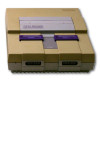 Leave It Alone – In the world of antique furniture, collectors most often desire an aged look. Stripping chipped paint, polishing corroded copper, or filling in scratches considerably lessens the value of the item because such “defects” show how old it is. Collectors of the future may appreciate discolored plastic for that exact reason.
Leave It Alone – In the world of antique furniture, collectors most often desire an aged look. Stripping chipped paint, polishing corroded copper, or filling in scratches considerably lessens the value of the item because such “defects” show how old it is. Collectors of the future may appreciate discolored plastic for that exact reason. Magic Erasers (melamine foam) – Great for surface dirt. Good for very light surface discoloration, but it will rub off painted logos and subtle textures like an abrasive.
Magic Erasers (melamine foam) – Great for surface dirt. Good for very light surface discoloration, but it will rub off painted logos and subtle textures like an abrasive. Sandpaper – Scrape your way to fresh plastic underneath. Not recommended for historical purists or console rights activists.
Sandpaper – Scrape your way to fresh plastic underneath. Not recommended for historical purists or console rights activists.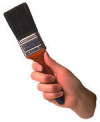 Paint – Cover up that ugly yellowed plastic and turn your SNES into a shiny ode to Heinz ketchup.
Paint – Cover up that ugly yellowed plastic and turn your SNES into a shiny ode to Heinz ketchup.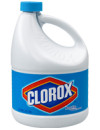 Chlorine Bleach – I’ve had very limited success with letting bleach sit on Macintosh cases. When it does work, it’s difficult to get a uniform effect unless you can soak the whole piece in bleach equally. This probably damages the structure of the plastic and might cause another type of yellowing — so beware!
Chlorine Bleach – I’ve had very limited success with letting bleach sit on Macintosh cases. When it does work, it’s difficult to get a uniform effect unless you can soak the whole piece in bleach equally. This probably damages the structure of the plastic and might cause another type of yellowing — so beware!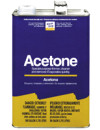 Acetone – Many people have mentioned acetone as a good way to clean off some plastic yellowing. The only reason this might work is because most plastics dissolve in acetone. If you use this method, be aware that you’re doing damage to the plastic — you’re wiping it away.
Acetone – Many people have mentioned acetone as a good way to clean off some plastic yellowing. The only reason this might work is because most plastics dissolve in acetone. If you use this method, be aware that you’re doing damage to the plastic — you’re wiping it away. Hydrogen Peroxide (Added 02/22/2009) – In the last year or so, a new method of reversing yellowing has cropped up in some corners of the net (dubbed “Retr0bright”) that involves hydrogen peroxide in high concentrations (10%-15%) and exposure to UV light.
Hydrogen Peroxide (Added 02/22/2009) – In the last year or so, a new method of reversing yellowing has cropped up in some corners of the net (dubbed “Retr0bright”) that involves hydrogen peroxide in high concentrations (10%-15%) and exposure to UV light.
If other people’s experiences are any indication, this process seems to work if applied properly. But remember that even if discoloration is reduced, your cases will yellow again some day unless coated with an oxygen-proof sealant after treatment.
Be warned: hydrogen peroxide in high concentrations is very dangerous (it can blind you and burn your skin), and this method can cause permanent damage to plastic if done improperly.
Despite numerous demonstrations of this technique and a seemingly sound theory behind it, the jury is still out on whether this method harms plastics or color pigmentation in the long-term. Be that as it may, this technique is currently the best, least-destructive method we have of reducing yellowing in ABS plastics.
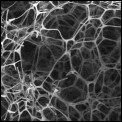 I have recently overheard a number of collectors talking about using “Mr. Clean Magic Erasers” to clean their computer cases. Magic Erasers are incredibly effective at removing surface dirt, smudges, or cigarette smoke film (when it’s not chemically bonded to the plastic). But using them to combat intrinsic case yellowing is another story all together.
I have recently overheard a number of collectors talking about using “Mr. Clean Magic Erasers” to clean their computer cases. Magic Erasers are incredibly effective at removing surface dirt, smudges, or cigarette smoke film (when it’s not chemically bonded to the plastic). But using them to combat intrinsic case yellowing is another story all together.
Magic Erasers are made entirely of a substance called melamine, which is lightweight, heat resistant organic compound which has, in the case of Magic Erasers, been extruded into a microporous foam. Until someone discovered its cleaning properties, melamine was used primarily as a flame resistant sound-proofing material and as an ingredient in resin laminates. Melamine foam has a microscopic open-ended bubble structure that, with the aid of water, finds its way into previously impossible-to-clean cracks, crevices, and textures.
Despite their amazing cleaning potential, Magic Erasers are no more than fancy abrasive pads, complete with all the drawbacks that entails. Which means that you should exercise caution while using Magic Erasers or other melamine foam products. Magic Erasers essentially act like extremely fine-grade sandpaper that will wear away any surface over time with repeated scrubbings. It happens so slowly, however, and on such a small scale that its effect is hard to notice at first. But if you keep rubbing and rubbing, you’ll wear more and more of what you’re rubbing away. Permanently.
Magic Erasers are capable of removing discolored plastic to a limited extent, but you’ll have to scrub very hard and you’ll lose surface texture in the process. I tried scrubbing for about ten minutes on both SNES and Mac LC III cases with melamine foam, but the results were unsatisfactory due to the smoothing of the cases and the paltry reduction in yellowing. If you’re into abrasives like that, you might as well use sandpaper for a quicker result (but you’ll regret it). Save the Magic Erasers for surface dirt only.
A Gallery of Dysfunctional Plastics
Finally, with all that other stuff out of the way, I thought I’d show you some more pictures of plastic discoloration. They range from SNES cartridges to video monitors.
Enjoy, and help keep plastics clean and beautiful.
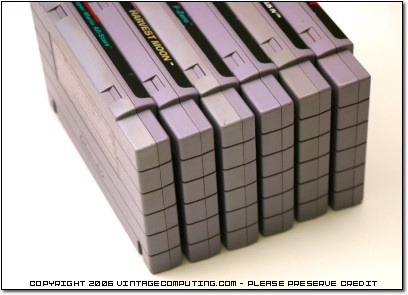 SNES cartridges are not immune to the vagaries of plastic discoloration.
SNES cartridges are not immune to the vagaries of plastic discoloration.
Like the SNES unit itself, sometimes two halves of a cartridge case
will age differently due to different manufacturing runs.
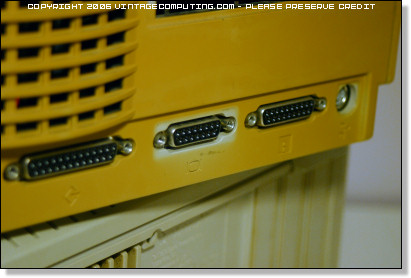 UV at Work: This computer sat in sunlight for years with a monitor connected.
UV at Work: This computer sat in sunlight for years with a monitor connected.
Notice how the monitor connector shielded some of the plastic from
discoloration, preserving the original gray color only in that spot.
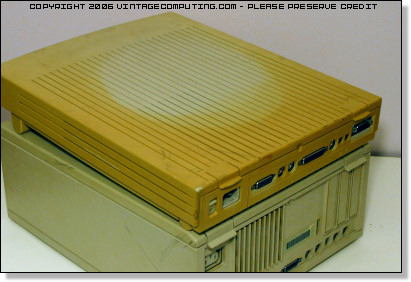 Here’s one where a monitor sat on top of a Mac for years, shading
Here’s one where a monitor sat on top of a Mac for years, shading
the plastic underneath from exposure to sunlight.
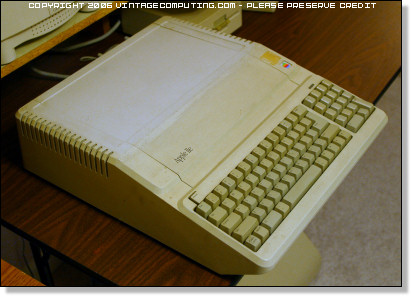 This poor Apple IIe Platinum has been the victim of discoloration too.
This poor Apple IIe Platinum has been the victim of discoloration too.
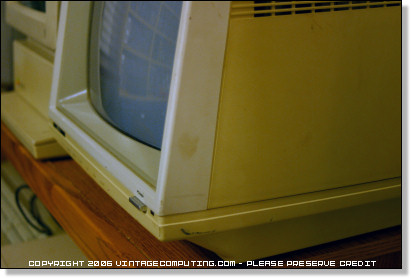 Yes, most of my equipment looks this bad! This discoloration is the result of this
Yes, most of my equipment looks this bad! This discoloration is the result of this
monitor sitting in a room with fluorescent lighting as the only light source for a very
long time. The two parts of the monitor were originally the same light gray color.
[ Update: 06/26/2008 – Si vous voulez lire l’article en Français, vous trouverez une traduction ici. (As of 03/08/2010, this French translation link is dead.) ]


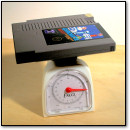

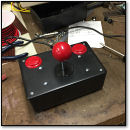
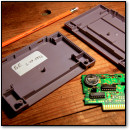
January 12th, 2007 at 6:51 pm
Nice write-up on an annoying problem — and I especially appreciate the fact that you actually did some footwork for it.
January 12th, 2007 at 7:52 pm
Agreed, great article.
January 12th, 2007 at 9:50 pm
Excellent article! I was talking about this in a forum a few days ago…
January 12th, 2007 at 10:05 pm
Great article. The top part of my SNES is also discolored and I’ve wondered about this for years. Finally put to rest!
January 12th, 2007 at 10:09 pm
sir, you would put Quincy to shame a fantastic article well researched and very interesting, i’m wraping up my console collection as i type.
January 12th, 2007 at 10:16 pm
The bottom of my SNES is discolored though not quite as bad as your top is. This is odd though cause you would think the top would receive more light although maybe your onto something with the additives. Maybe the day they made my SNES the mix for the bottoms was off and the tops was perfect!
January 12th, 2007 at 10:31 pm
Why Super Nintendos lose their color
Here’s a VERY informative article explaining why exactly your Super Nintendo or even your old NES may be changing colors, what can do about it (if anything), and how to prevent it. Maybe I just liked it because I’m the kind of person who l…
January 12th, 2007 at 10:43 pm
So, my question is this: Is it all fluorescent light that harms plastics? Or only that that shines directly on the plastic?
For example, if you have the fluorescent bulbs that replace regular incandescents, if they have a lamp shade, so it shines through the shade and indirectly hits the material, will it have the same effect, less effect, or no effect?
January 12th, 2007 at 10:49 pm
Kevin,
Unfortunately, all fluorescent light (that I know of) discolors plastics. I have a white cordless telephone in my office that has been discolored to yellow drastically in only a few months after being hit by incident (indirect) light from one of those incandescent-replacement fluorescent light bulbs, which is located nearby. I’m not sure how much UV filtering effect a lamp shade would have, but as long as the light can bounce around, you’re going to see some sort of yellowing effect. It shouldn’t be as drastic as direct UV exposure, though.
It’s kinda scary, because I have started using fluorescent bulbs in most of my rooms with my classic computers in them, and I’m worried about them yellowing — but there’s really not much I can do about it.
By the way, thanks for all the wonderful comments, guys. I’m really glad you liked the article.
January 12th, 2007 at 10:54 pm
This is a superb article on plastic dicolouration. I still find it hard to believe that the differences between manufacturing runs can be so different; I think perhaps there should be better quality control in these places. Is the structural strength and durability of the plastic affected at all?
January 12th, 2007 at 11:13 pm
John, from what I’ve read, oxidized plastic does get more brittle and its durability does change, but I suspect that the degradation only significantly affects the plastic’s structural integrity in extreme circumstances, such as after prolonged exposure to direct sunlight over a period of years. So as far as game consoles and computers go, I wouldn’t worry about it. Just don’t use your Super Nintendo as a stepping stool and you’ll be ok. 🙂
January 12th, 2007 at 11:33 pm
[…] Click here to read more | Source […]
January 13th, 2007 at 1:36 am
Excellent write. I wasn’t able to read the article right away but was able to give some thought to what could cause the discoloration of the plastics. Oddly enough, I was thinking of oxidation of the plastic much like rust on metal.
If you don’t mind, I’ll be linking to this article from my website just because it is that damn good. Great job.
January 13th, 2007 at 3:34 am
[…] A very informative article on why old systems and specifically the SNES get discolored. I always figured it was something in the plastic and that light might also have something to do and turns out I was mostly right. [Link] Filed under: Video Games, Geek Posted by Mark on 01.13.07 | Related Entries […]
January 13th, 2007 at 5:20 am
Nice piece. I’d also recommend keeping your systems out of the garage, attic, or anywhere else that isn’t in a temperature controlled environment. I had some things in a storage area at the top of my garage that I recently took down and they yellowed. Luckily it was mainly some toys I didn’t care about much. I’m assuming it got too hot at the top of my garage.
January 13th, 2007 at 5:48 am
Great piece! I’ve wondered what kind of process was yellowing my SNES for a while now.
January 13th, 2007 at 10:16 am
Benj,
Awesome work! I have pondered this same question from time to time. One thing regarding the discoloration on one half of the SNES and its carts…
Is it possible that the one-sided-ness is due to heat disapation being directed to one side instead of the other?
The detail in your article puts you above others. Good job, man.
CG
January 13th, 2007 at 10:25 am
very good info.However do not use bleach on any plastic,yellowed or new.The bleach will destroy plastic.
January 13th, 2007 at 10:32 am
A couple of other remedies are a mild bleach such as hydrogen peroxide ( drugstores).
I admit I have never tried this. It may be too weak a bleaching agent or it may be useful in mild cases.
The real tip I will share is the carefull ( very carefull) use of oven cleaner ( the spray type – a form of lye is usually involved as the active ingredient).
Spray it on. Wipe it off in a minute or two. Do not forget that you have applied at as the agent is quite harsh.
I know it removes cacked on tobacco residue very well. It removes it as sort of a film as you wipe it off. Best to follow up with some water or soap and water on a cloth to remove any damaging residue just in case.
January 13th, 2007 at 10:32 am
I operate a small tanning salon. As you can imagine, there is A LOT of UV light generated by a tanning bed, which has many white plastic parts.
Regularly we use a product to “bleach” the plastic. Once applied, we let is sit for several minutes applying more if it dries up. Then simply wipe it off. The plastic whitens greatly and the rag turns a yellow color. Its almost as if their product pulls out the discoloration. The product is available anywhere, its Scrubbing Bubbles. I also use it to remove road tar from my car 🙂
As a avid Mac collector, I greatly appreciate this article!
January 13th, 2007 at 10:50 am
great article, thank you.
January 13th, 2007 at 10:56 am
I’ve been aware of this problem for many years. It is oxidation, as you’ve discovered, agrevated by heat and uv. There are only two solutions:
1. When new out of the box, a generous application of “Armour All” or “Son of a Gun” (or similar protectant) , and yearly re-applications, will stop the discolorations.
2. Krylon makes some colors that can be a perfect match for certain original equipment. If applied properly, can be hard to detect. (application technique is important. clean well first. very thin coat, may be followed with thin coat of clear mat finish as new paint is glossy. be careful for logos and decals may be lost.
January 13th, 2007 at 12:19 pm
That is a very thorough write up, I admit I am impressed by the amount of research you carried out in the name of plastic decolouration.
January 13th, 2007 at 12:42 pm
[…] http://www.vintagecomputing.com/index.php/archives/189 […]
January 13th, 2007 at 12:49 pm
[…] This article at Vintage Computing explains the phenomena of yellowing plastic – it’s actually a reaction caused by flame retardants. […]
January 13th, 2007 at 1:02 pm
I find acetone works very well to remove the faint yellowing of some plastics. If you can’t find pure acetone, you can usually find a small bottle of nail polish remover which has acetone in it.
January 13th, 2007 at 1:04 pm
wow, I’m extremely impressed with how much work you put into researching this. Also, instead of sandpaper, often steel wool works better.
January 13th, 2007 at 1:18 pm
When the yellowing is at it’s highest point like in some of those pictures, it looks cool. If both sides on my SNES turned that colour I’d leave it and say I have a limited edition gold SNES.
January 13th, 2007 at 1:30 pm
[…] read more | digg story […]
January 13th, 2007 at 2:24 pm
[…] Why the SNES loses it’s color […]
January 13th, 2007 at 2:51 pm
God, that would really suck. My brother got rid of the NES & SNES back in the early 90’s. Geez, I hope this doesn’t happen to my Wii!!!
January 13th, 2007 at 3:09 pm
Awesome article! My SNES is also brown as a vagrant’s teeth, but Digital Press said it was because Nintendo was cheap and used a crappy plastic, and switched out later in the system’s lifetime. Glad I know better now! ^_^
January 13th, 2007 at 3:09 pm
Much appreciated your clear-headed approach! Some additional data: 1) Try oxygen bleach, instead of regular bleach. Regular chlorine bleach will change the bromine-moderated yellowing into a chlorine-moderated yellowing. Chlorine bleach is toxic (by attaching chlorine to organic compounds, e.g. plastic and yourself), and yellows things all on its own (try this out by over-bleaching something). 2) The bromine-based fire retardants are very toxic in the long term, spread over the earth from pole to pole, and tend to stay very long in the environment. They disrupt endocrine (gland) function and reproduction. Communicate with manufacturers that we don’t want them anymore (Europe, of course, is getting rid of them). 3) Fluorescent lights work by generating UV from mercury vapor, which then stimulates phosphors on the inside of the tube. Fluorescents leak UV and are somewhat bad for your eyes (your eye proteins degrade like the plastics), and have an extremely “peaky” or “spiky” spectrum, which stresses you far more than the equivalent amount of natural light. Also, when you throw out the tube, you release a drop of mercury into the environment. Until LED general lighting arrives, halogens are a healthier reasonable-efficiency choice.
Again, your writeup excellent! Thanks!
January 13th, 2007 at 3:54 pm
[…] read more | digg story […]
January 13th, 2007 at 3:56 pm
Please share with your readers that a recent investigative television show has determined Mr. Clean Magic Erasers contain a cancer-causing agent. If you plan to use them to clean plastics or any other surface, please take the precaution of wearing plastic gloves. [Editor’s note: This is not true.]
Thank you for answering the question of why plastics yellow over time. It was an informative and enjoyable read.
January 13th, 2007 at 4:06 pm
Great article. Instead of the UV Resistant Clear Coat, you could opt for a product such as 303 Aerospace Protectant. It is a UV protectant, doesn’t make things shiny or greasy, and is safe for plastic.
January 13th, 2007 at 4:17 pm
Thanks for the article! I’ve been looking for an answer on this for years. For a long time, I housed my SNES in a wooden cabinet I built in high school wood shop and stained/sealed myself. It was inside a little door so it wasn’t exposed to light at all and I thought it may have been exposure to a poorly sealed stained wood cabinet, but keeping it inside a cabinet may have held some of the unit’s heat inside, discoloring the unit faster.
I just hope my Wii never turns that color! 🙂
January 13th, 2007 at 4:23 pm
I was wondering, does the same thing happen with the dreamcast?
January 13th, 2007 at 4:49 pm
Very interesting article on the Super Nintendo and its skin condition. Thankfully, my SNES is still good looking, but it has a tint of “that” look. Nintendo makes good products and a skin disease isn’t too big of a deal, as long as the machine still works fine. 🙂
Paul Gale
1up.com
January 13th, 2007 at 5:20 pm
Finally a good reason to keep my cartidges in their boxes all these years. I feel like I should make some sort of protective case for the system now.
January 13th, 2007 at 5:26 pm
I don’t see why painting is not an option. True it’s not exactly historically correct but neither is discolouration. The texture is not going to be the same either but all in all I think it’s better to have something that looks like the designer originally intended, than putting up with such disfigurement.
It should be quite easy to find a paint colour that comes very close to the original and making sure it’s not too shiny.
Then just spray it on, on a sunny day in thin even coats, and the result should be quite pleasing.
January 13th, 2007 at 5:31 pm
Sqeuak, painting is an option. It’s Restoration / Repair Method #4 in the article’s list.
January 13th, 2007 at 5:56 pm
I thought I had made this clear enough in my article, but I will have to say it explicitly here: The yellowing that occurs in plastics is of an internal chemical nature that cannot be removed without some sort of damage to the plastic itself, whether by abrasion, oxidation, or dissolving. The only non-destructive restoration option is to paint the plastic and cover up the yellowing. Sorry, folks, but there’s no way around this.
I also added an item about acetone in the Repair & Restoration Methods above. But beware — acetone dissolves plastics.
January 13th, 2007 at 6:36 pm
Working with computers/consoles for all my life has taught me a cleaning trick of my own which wasn’t included in the list here.
Fantasic!
Seriously, a little spot on the corner of a sponge will wipe cigarette smoke residue dirt and anything else I’ve ever come up against off of computers.
😉
January 13th, 2007 at 6:40 pm
In case you didn’t understand what the article is about this is plastic discolouration not smoke film or dirt.
January 13th, 2007 at 6:48 pm
Brian Crazwell, it’s just the way the painting is presented in the article, almost jokingly, when really it is the only option *and* it can look really nice if you take care and disassemble the console first and separately spray paint each part.
January 13th, 2007 at 6:59 pm
I agree with Squeak, and I have edited the article to reflect it. I actually didn’t really think of trying to recreate the original console’s color via paint when originally writing the article, but it does sound feasible, if difficult.
January 13th, 2007 at 8:09 pm
Fantastic, fantastic, fantastic write-up. Thank you!
January 13th, 2007 at 9:13 pm
Excellent article! This explains why some of my vintage computers (for example, my Mac SE/30) have yellowed badly, while other even older systems (like my VIC-20) remain paper-white. Different plastics, different additives, different results. Also great to know about keeping the systems away from temperature extremes. Thanks for this fantastic write-up.
January 13th, 2007 at 10:21 pm
[…] I thought this was an interesting article that was posted on digg.com. My SNES has done the same and I wondered if anyone else had this happen before. Vintage Computing and Gaming | Archive » Why Super Nintendos Lose Their Color: Plastic Discoloration in Classic Machines […]
January 14th, 2007 at 12:44 pm
Great research for a fine article! Thanks, Benj.
January 14th, 2007 at 1:11 pm
If you could find a “Never Opened” SNES console on Ebay; Would the plastic be discolored? I would love to find one.
January 14th, 2007 at 3:20 pm
[…] Check out the article here at Vintage Computing. Share and Enjoy:These icons link to social bookmarking sites where readers can share and discover new web pages. […]
January 14th, 2007 at 4:02 pm
that is the most detailed article that is going to be printed on the subjected of discolorization ever. good job!
January 15th, 2007 at 4:37 pm
[…] He aqui un interesante artÃculo sobre la decoloración de las carcasas de nuestras queridas computadoras y videojuegos retro. En pocas palabras no hay nada que se pueda hacer para evitarlo una vez ha pasado, solo pintarlo. Pero si aún no ha sucedido, entonces no todo esta perdido. […]
January 16th, 2007 at 4:59 am
Wow. Will this affect the N64, Gamecube or Wii in any way?
January 16th, 2007 at 5:03 am
I ave the same problem only the top is yellow. There should be replacement cases. Or a class action lawsuit.
Maybe skins
January 16th, 2007 at 2:32 pm
Agree with …
My Apple II Platinium was painted last year with a painting for plastic’s car,
with the same colour as at its first days : it’s now a true visual pleasure to find it thus.
Thank you for the great contents of your article …
I sent a copy of your article to my father which is 86 years old ( he was a chemical engineer and was specialized in the plastics ( Cd-roms, polyethylene ) ; his answer was : here is a interessant article and intelligently written …
Best regards from France
Phil
January 16th, 2007 at 4:16 pm
one way to avoid this is to design yellow plastic items, it could be the new “white ipod” look.
January 16th, 2007 at 11:00 pm
I’ve always stored my video games and systems inside cabinets when not in play, with the exception of my Xbox and GameCube. Both are black so if they contain to same cheepo properties, no one will ever notice….however if they finally got things right with the last generation of the MK I SNES, why would any future Nintendo product suffer from the discoloration fate?
I’ve noticed the same problem with old GameBoys (I have a clear/transparent one that is unaffected) and even some original Playstations….
January 16th, 2007 at 11:00 pm
Thanks for bringing all the scattered views on this subject into one cohesive article. Now I understand all the angles as one.
January 17th, 2007 at 6:42 am
[…] Why classic computers and video game consoles turn that yucky yellow-brown colour with age, and what you can do about it. Short answer: not much. […]
January 17th, 2007 at 10:30 am
Note that the yellowing of plastics isn’t exactly a new phenomenon; it was present as far back as the 1930s in a popular plastic called Catalin:
http://en.wikipedia.org/wiki/Catalin
Light causes Catalin to change from white to a pumpkin or butterscotch yellowish-orange colour:
http://www.maarc.org/Articles/Catalin_Corner/catalin_corner.htm
In more recent times, some manufacturers intentionally made differing case parts different shades so that, as the plastics in each portion of the case aged, the colour shift wouldn’t be perceived as a problem (“If you can’t fix it, feature it!”).
Dave
January 17th, 2007 at 11:23 am
Wow, actual journalism on a blog! I’m impressed. This site’s getting bookmarked!
(And I thought they just made stuff that ugly yellow color back then…)
January 17th, 2007 at 1:35 pm
I’d like to add exra emphasis on the warning against usiing acetone (or anythign that contains it, like nail polish remover) on plastics. Well over a decade ago, I tried cleaing off the usual buildup of dirt/oil on my Super NES, with nail polish remover. It didn’t completely destroy the plastic, but it did alter the surface of the plastic. You can see some light swirl marks where I tried using it.
As a side note, my Super NES has not changed colors, and is one of the earlier models where, when you slide the power switch to ON, a small plastic tab is pushed forward in the cartridge slot (this was originally to keep people from pulling out the cartridge while the system was on; this was apparently removed because of some sort of patent infringement. The non-yellowed SNES in this article has a sticker just below the power switch; these models usually do not have this mechanish in them.
January 17th, 2007 at 2:37 pm
Awesome article.
You’ve answered the question on many people’s minds over the years.
^_^
January 17th, 2007 at 3:24 pm
this happens to surfboards as well. the spots where the wax is, block light and when you go around to clean the wax youll have splashes of decoloration. very irritating. buy yellow boards.
also, i think its a matter of learning to appreciate it, its old, its yellow.(more like orange) its somewhat beautiful.
January 17th, 2007 at 3:48 pm
not sure about this but i believe the auto industry used to “stain” vinyl interiors before they started painting them, perhaps there is some kind of stain to use that wouldn’t build up like paint and leave an un-original surface. the yellowing might just show up through the stain tho, just a suggestion.
January 17th, 2007 at 5:09 pm
I found this very interesting, but am curious if using skins on console cases (Wii), even portable game systems (Ds) would trump the effects as it would block the UV light.
January 17th, 2007 at 8:21 pm
[…] Vintage Gaming has a huge article on Why Super Nintendos yellow with age. […]
January 17th, 2007 at 8:48 pm
Dollars to donuts that machines that haven’t been exposed to UV would still be grey; similarly, if you’d had your machine turned upside down for the entire length of time you’d had it, I bet it’d be the bottom that turned yellow (due to that whole ‘heat rises’ thing.)
January 17th, 2007 at 8:56 pm
moof,
The discoloration of the SNES is not due to heat, specifically, but due to exposure to oxygen in the air. Something in the plastic mixture in one half of the SNES’s shell is causing the case to yellow by simple exposure to oxygen. UV is not a factor at all in the most common form of SNES discoloration, and heat is not a major one, although it likely accelerates the oxidation process.
Some people’s SNESes discolor only on the bottom, or the top (like mine), or on both sides evenly. Which side(s) get discolored is based only upon the luck of the draw — that is, which plastic batch was used to create each part of the plastic shell when the consoles were being manufactured.
January 17th, 2007 at 10:50 pm
Great article it made me remeber i had my snes in a draw for about 7+ years and at the time it was the normal grey now its discoloured at the top. Maybe its air!?!?
January 18th, 2007 at 10:21 am
Great article! lots of good research there.
January 18th, 2007 at 11:25 am
[…] The folks over at Vintage Computing and Gaming did a great job hunting down the answer. Not only did they answer the question, but they went a step further by interviewing someone who should know: […]
January 18th, 2007 at 2:54 pm
Interesting, well-researched article. Articles like this is why the internet doesn’t suck.
January 18th, 2007 at 8:28 pm
Thankyou for taking this issue of plastic discolouration seriously, my SNES looked cheap and dirty after a yer of use and now i understand why, great write up.
January 19th, 2007 at 12:13 pm
Nice research, my teacher from the class of polymers suggested to read it to get more interest about it, and is incredible the different kinds of plastics from which things are made and all the phenomena that can occur with polymers. Thank you. Good effort
ITESM. Mty
January 19th, 2007 at 1:17 pm
A fanstastic article! Great work!
January 19th, 2007 at 2:24 pm
Be happy it turned into that color! Now it looks like a special edition limited time only gold plated SNES!
January 19th, 2007 at 7:43 pm
I have always thought that it was the sunlight, and yet it makes much more sense that it is something in the air as well—especially in the case of that Apple with the spot where the monitor was sitting. The monitor blocked the sun and the air! Interesting stuff!
January 21st, 2007 at 7:17 pm
Wow! I’ve been a SNES owner for years and I’ve gone through at least a couple of them. I currently own one that is discolored, while my last one was not. My initial reaction to it was it looked like someone had dug it up from somewhere. So today I finally decided to search for an answer, and here it is! This actually makes sense to me because my arctic Game Boy Advance is also discolored now. Perhaps it’s the same type of plastic? Very interesting article on how the elements can affect man-made materials. Good work finding this out! Thanks!
January 23rd, 2007 at 1:58 am
[…] Link:Original Article […]
January 23rd, 2007 at 6:46 pm
Plastics: “Vintage” is Sooooo Out
Plastic(s) can be a skanky bitch. Over time it can become brittle, chewed up, over-utilized and salty to the taste. But on day-one, it looks so beautifully pristine that you promise yourself you will buff it every day, and keep it as pretty as possible.
February 1st, 2007 at 3:20 pm
Thanks for the article. the other day I brought my apple IIGS out of a room I use for storage that has a big sliding glass door.
5 years ago the apple had none of this nasty yellowing that it does now.
So mad at self, Will certainly be using an incandescent now that the computer is inside.
February 1st, 2007 at 8:04 pm
Interestingly, my NES and SNES both look brand new. The N64 does, too, but that’s beside the point.
February 7th, 2007 at 10:09 am
So i’ve been trying the bleach thing on my SNES. First I tryed maybe 80% water, 20% bleach for two days and it’s still yellow. Then 50 50 for two days, still yellow. 100% bleach for two days and still yellow…
I had more just expected it to work rather than was I testing it, so I don’t know if it improved or not.
I’m wondering a couple things for anyone that might be able to answer; 1. does it matter what kind of bleach, i just used the cheapest thing of bleach I could find.
2. How long should I let my SNES sit in it, and would it make a difference if I scrubbed it after its been in the bleach for a while?
February 7th, 2007 at 10:52 am
Ethan,
If you soaked the whole thing in 100% bleach and it hasn’t had any effect on the yellowing, then you should probably stop before it damages the plastic. Someone mentioned that bleach may actually cause the SNES to yellow more but in a different way after prolonged exposure, so I really don’t recommend it. I only added bleach to the list because it might work to a limited extent in certain circumstances (like on Mac cases). Apparently, if your experience is to be a guide, it doesn’t work on the SNES. And no, it doesn’t matter what kind of bleach you use, as long as it’s “standard” bleach.
February 7th, 2007 at 1:32 pm
I used to work for a company who specialized in vintage gaming and our biggest head-pounder was SNES consoles’ discoloration. We’d get dozens in at a time and most looked like they’d been marinating in spit-out chewing tobacco. Thanks for the excellent article and many kudos on the thorough research. You’ve answered a question that has for too long rented space in my brain.
February 8th, 2007 at 4:32 am
Hi, thank you for this incredibly well researched article! I have listed an old word processor on ebay and did a google search to try to discover tips on removing the yellow discolouration prior to sending it, but really did not expect to find such a fantastic piece of work. If only manufacturers were as committed to resolving issues which may not arise at the point of sale but are very important to their customers in the long run!
Kathryn from the UK
February 9th, 2007 at 8:54 am
As stated before if the Nintendo Wii, or Playstation 3, or other console is made of ABS plastic it will turn yellow with time.
It make sense, my monitors turn yellow sooner than anything else (heath source).
It’s not just light, or UV, my commodore 128 has been 10 years in their box and it’s turning yellow, the oxygen it’s till there.
February 13th, 2007 at 1:14 am
Great article, I bought my Super Nintendo when it was released in 1991 and started noticing the yellowing about 5 or 6 years ago. Mine is yellow all over except for the center peice, the controller ports and the EXT piece on the bottom. I live in British Columbia and would estimate about 90% of the systems that I’ve seen locally are at least a little yellow on some part of the unit although I’ve never seen one where the center peice or the EXT piece have changed colour.
About a year or two ago I called Nintendo of America and asked about why they turn yellow and the guy there told me that he’d never heard of it and said he’s also had his Super Nintendo since 1991 and his still looks good as new, he then put me on hold and asked a colleague who’d also never heard of it leading me to wonder if it was a problem unique to Canada.
I wonder if any one has noticed that in certain countries or certain parts of countries the problem is worse than others due to the platic being manufactured in different factories or if certain serial numbers/years produced are not affected or not affected as much? It seems when I look on ebay alot are discoloured but alot also appear to be unchanged colour wise. I also wonder if keeping the system in a sealed plastic bag would prevent discolouring or maybe slow it down, I suspect not but maybe someone else has an opinion.
Again, thanks for writing such a great article, it’s good to know there’s someone out there who will do such a thorough job researching and answering a question many people have pondered for a long time.
Chris in Burnaby
February 18th, 2007 at 3:11 am
Hi, thanks for this. I just found an old Apple LaserWriter in the street and assumed it was discolored from being in a smokey environment. Was wondering how to clean it. Now I know not to waste my time. Your scientific approach earned my respect where I otherwise may have been skeptical.
February 18th, 2007 at 3:39 pm
Thank you for a well rounded, nicely written article, with pictures that speak a thousand words.
Like you, I’ve been pulling out some of my old relics, and discovering yellowing, and my shop has much flourescent light. I will be changing the lighting to spot halogens, but of course they emit heat – so that may not help much. It appears the lead lined, temperature controlled vacuum chamber is the only way to store things made of plastic and keep them new. So, I am going to favor painted metal casings on equipment purchases I make in the future, use UV protectant and temperature control on plastics I already own, and paint everything else that is already too far gone. As far as the “Gold” version, I can only say it looks more like the color of a liquid I’d rather not say here. Plastics use petrochemicals, so ultimately they should all turn to some off-shade color of motor oil, offset by flame retardants and catalysts, and whatever was used that day of manufacture…
February 19th, 2007 at 12:53 am
As an ancillary note: on closer examination of some of my own old computers, I’ve found much of the discoloration appears to have been caused by exposure to light, but I questioned why the discoloration was even worse in places that could not have been exposed to direct sunlight or flourescent lighting, such as on the rear area that would have faced a wall. Then it hit me – perhaps these areas were discolored because of the exposure to the UV (and Xray?) emissions from the monitor itself!
I’m curious just how much is in the rays that come out of a monitor, and how that compares with normal daylight and flourescent UV aging of plastics. Interesting that maybe the very device these systems were designed to operate attacks back – albeit only cosmetically.
February 19th, 2007 at 8:04 am
Has anyone ever thought of trying to deliberately apply a gradual ‘Blue dye’ to try and compensate for the ‘yellowing’? It might end up a more ashen or grayish color, but its a thought.
Another thought is some type of penetrating Titanium Oxide wash, not so much paint as something that would penetrate or attach itself to the plastic and make it reflect more light.. I guess thats akin to a paint.. just a more subtle one.
Eye glasses get tinted films, so there must be some type of penetrating film or dye that could be applied.
I would think dipping would be more uniform, and the slower the penetration the more uniform the coating.
As for lightening.. I again have to think some type of penetrating or very subtle ambience enhancing coating would help. Perhaps a type of electrolysis? If we’re talking about dipping.
Which reminds me of those “wipe on” electrolytic type washes.
Once its all said and done though, a stablizer (some type of antioxidant) coating and a sealant would make a lot of sense.
February 24th, 2007 at 11:23 pm
I have discovered a PPG paint color that matches up almost dead nuts to
older macintosh cases.You might have to lighten it or darken it slightly to preference.
March 2nd, 2007 at 1:24 am
And that color would be?
March 12th, 2007 at 9:05 am
So eventually our current gen 360s, Wiis, white PS3s, DS lites (which I think have coating though), new computers like Macs, IPods (I always said get a Zune), white monitors, PSX, gameboys, they will all yellow eventually. How sad.
March 22nd, 2007 at 6:43 pm
How can I prevent this discoloration, what is the best way to prevent the discoloration, and how can I get rid of general dirt and grime that that has accumulated over the years? (especially on the eject button)
Really Good Article!!
March 24th, 2007 at 11:39 am
I’ve been trying stuff for this problem for a while. I have found that for surface dirt, oxidation, and cigarette stains what works best is the easy off BAM. For the yellowish of the plastic, if it is light, you can try and use the Novus plastic cleaner no.3. It’s an abrasive, so be careful with the logos and read the note about using rotatory tools.
Also, why use that white or light gray color when producing an electronic device? couldnt they just use black? it looks better and does not suffer decoloration.
March 25th, 2007 at 8:41 am
Great article indeed,
I had limited success cleaning a TI59 printer craddle with Acetone, thus however removing in part the texture. Seems as if TEXAS vintage computer case yellowing only occurs on the surface.
April 6th, 2007 at 1:14 pm
I too have yellow bottoms… (on my SNES).
I always wondered why and now I know.
Maybe we could all start trading our cases so at least the discoloration will match for some of us.
-Luis
April 17th, 2007 at 10:22 am
Fantastic article. I was wondering why this was happening to the plastic all around my home. Now living in California, where lawmakers are considering a ban on the “old-fashioned” incandescent bulbs beginning in the year 2012. I have new concerns on how the ” low energy long lasting compact fluorescent bulb” they are mandating will impact this problem.
-Amy
May 22nd, 2007 at 12:09 pm
And I thought my older fax machine was yellowing since it was hidden away and not exposed to UV while others in the light were normal grey colored. I am so glad I saw this article first and did not spend wasted hours trying to find a way to clean it.
May 24th, 2007 at 10:21 am
Thanks for this – I found it while google searching “removing yellow stains on old computer equipment”. A bit of a downer, though, as I was hoping to find a nice easy cleaning tip, such as “use lemon juice” or something. You’ve probably saved me an awful lot of fruitless effort, though.
May 25th, 2007 at 9:06 am
Great Article… it’s hard to find useful information like this anymore and I applaude you for doing all that research. Now I can stop scrubbing so hard…
May 30th, 2007 at 1:35 pm
I was lucky enough to have an SNES that was not effected by discoloration. It was kept well away from sunlight and fluorescent light. Not that I’d really care if it did turn yellow because it’s not like it would stop working as a result. Discoloration is far more infuriating on things where form counts more than function, such as my vintage Kenner Star Wars Millenium Falcon. When I first got it in the late nineties it was the least discoloured Falcon I had ever seen, besides photos of pristine examples on the internet. In the decade that I’ve had it I’ve seen a very gradual deterioration, which was unavoidable short of locking it in a vault as you mentioned. Sanding it or painting it is absolutely out of the question.
May 30th, 2007 at 1:50 pm
Before writing this article, I was under the impression that “plastic is forever,” as if all plastics were the most inert, stable compounds ever made that would always be around. After all, that’s what environmentalists tell you about plastic litter, isn’t it?
So while certain plastics don’t biodegrade and will indeed be around for thousands of years (in some form or other), it’s amazing to think that regardless of that, all plastics actually do break down chemically over time, with results not just affecting aesthetics, like the color of a plastic item, but the item’s structural integrity as well. It’s having an impact on collectors of vintage radios and, like MuttonChops says, plastic action figures, that I’m sure no one conceived of when the items were originally produced. And now it makes me wonder whether future generations will ever see plastic historical artifacts as they were intended, aside from in pictures.
Just some thoughts. Thanks for all the comments.
June 4th, 2007 at 8:21 am
Thanks for linking me to this; I’ve always wanted to know why the bottom half of my SNES turned yellow.
Great article.
June 14th, 2007 at 5:44 pm
Great article! You said:”Flame retardants unstable to heat! How ironic.” No, it’s not ironic at all, think about this, during a fire your SNES has to suffer flame action, but nothing else, and your SNES has been chemically trated to present some fire resistance. But keep in mind that it’s impossible to prevent all degradation forms which will decolor your plastics, the goal of this is to retard the process as much as possible.
Some plastics have good tolerance to UV, some to heat, some to oxygen… but no one will resist everything.
Keep alive your curiosity!!!
June 23rd, 2007 at 9:40 pm
Odd, I was looking for “moldy bread” and this came up.
I read it and am most thank full, I for one have kepted my NES in a box and once in a while I will make sure it works and is cleaned… so no disscoloring and still looks new… in fact it plays like it too. I might put it into a bag (that is the box that it is in) and see if this would perserve it furter. I would love it if my children could play with it as much as I did. Teach them what gamming is about, not the next best 3D graphics, sound or anything like that. Just being able to play and have fun with friends and family.
This artical was vary informative, thank you for all the work you put into it.
A side note: how many of you would travel back in time to tell your self how to beat mario? (I was lucky, my greate uncle told me how after I was able to get to the last stage).
July 2nd, 2007 at 11:02 pm
Wow awesome article! So thoroughly researched and I love the comprehensible and fun style it is written in. AND I now know why my SNES is getting so discoloured on the bottom half. Thanks again and keep up the great work.
July 3rd, 2007 at 3:49 am
Excellent article. I was considering painting my old Commodore’s and consoles but the purist in me wont let me. I’ve even considered making casts of the original cases and making new ones. Its a shame mass production of consoles and classic computers calls for the use of such cheap plastics. Great work Benj Edwards.
July 30th, 2007 at 11:08 pm
Not UV, fluorescent light, sun, tobacco, temperature, plastic quality (rather plastic chemistry), or grime. It´s a combination of it ALL. Earth is actually a fish tank, of air…
Each matter, (us included) react differently to the local “atmosphereâ€. Fax, machines, boom boxes, radios, phones. In some cities, air is thick with chemical emissions. Such complexity deserves a thesis, (your thorough study hereon is a good start). Se we have “bad hair daysâ€, quick darkening silver, rust, mildew, and, plastic yellowing.
Now what puzzles me (the reason Google brought me here) is that over 15 years ago, I saw a man INSTANTLY bring back the snow white color of what looked like the original ivory tone of a 50´s red and white radio, on a Discovery Channel antique piece. My jaw dropped down. I begged the reporter to ask about what he called “special productâ€. He simply dripped a little on a white cloth, and with a single wipe, the yellow was gone! So, yes, there is a solution out there, and I´m determined to find it.
August 7th, 2007 at 2:34 am
Nice post! I’ve been wondering how this happens for some time now.
*bookmarks page*
August 13th, 2007 at 10:33 am
Apparently this problem is not limited to gaming, computers, and electronic gear. I stumbled on this article while looking for a solution to why my white kitchen appliances are now 2-tone. The plastic portions of my microwave door, doorhandles, etc of my refridgerator, coffee pot, blender, are all nicely yellowed in my fluorescent-lit kitchen. I was primarily concerned about health issues (was there some cancer-causing agent playing havoc in my kitchen?), but I’m also disappointed at the dinginess of my kitchen. I wasn’t a big fan of them, but my next appliances will be stainless steel! I really appreciated the thoroughness of the article. At least it laid my health concerns to rest. Thanks!
August 14th, 2007 at 10:00 am
Great Article! As a collector of vintage radios/TVs and old electronics, it definitely explains the phenomena I have been seeing with vintage electronics and computer items. I have been collecting/reusing mid-90s era Gateway computer cases and monitors and have been taken back by the number of these formerly white items yellowing just in recent years; some most unevenly. It is not always the different pieces that don’t match, but sometimes the same piece has uneven yellowing. In this case, I would be content with painting them with a white automotive vinyl die to brighten them back to their former glory. That would also help preserve their textured surface better than abrasives. I am not trying to preserve them historically as much as I like the looks of them.
I found this web site trying to find more information on why plastic yellows. I purchased a 1970’s era Zenith TV with a white plastic pedestal base. The seller gave me a decent condition one as well as a very yellowed (browned) base and I was not only wondering why this happened and why one was in better shape than the other but how to remove the yellowing. My better one still has rather evenly turned “computer” biege with some minor brown staining. It is only still bright white on the top where the TV sat mounted to it. As it only appears to be a film of yellowing on the very surface and since it has a very smooth finish, I was thinking of finding some sort of fine abrasive plastic polish; perhaps something from the likes of The Eastwood Company meant for auto restoration. In the meantime, I have moved them from my non-climate controlled garage, where it could get into the 90’s on a hot Summer afternoon, to climate controlled storage (where it is mid-upper 90s and flourescent light from the hallway can’t get in unless I open the door). Any idea what temperature is considered too hot? Is this level of protection sufficient or will they continue to yellow?
One more suggestion, particularly for the NES/SNES collectors. As a collector, it would seem that almost anything done to “restore” a vintage console would actually harm its “historical” value or at least, while understandable, would not be as valuable as one that has not yellowed; whether cleaned with a chemical agent, sanded or even covered with paint. A precisely matched and expertly applied coat of paint can be done imperceptibly but to me would still not be as accurate as an untouched console or even leaving it yellowed as “historically” that was how it was made. Perhaps however, good parts could be swapped from other consoles, replacing yellowed pieces from time proven, good parts to create a clean unit?
August 14th, 2007 at 10:03 am
I meant to say my climate contolled storage facility was kept in the mid-upper 80s above.
September 11th, 2007 at 8:04 am
Great Job!
Tks from Brazil.
September 26th, 2007 at 9:00 am
From my own experince with the SNES system is that if you clean it once a month with a glass cleaners like windex it will turn yellow. My first SNES system turned yellow within 2 or 3 years but my second system which I bought around 1995 still looks new, reason why it looks new is I don’t use any glass cleaners and I dust it once or twice a week with a DRY cotton cloth.
If you dust your system with a DRY cotton cloth every week then your system will not lose any color, my second system is 12 years old and still looks like new cause I took good care of it.
Dusting is the key to keep everything like new. 🙂
October 7th, 2007 at 1:31 pm
Congrats on the article. I ran into it trying to look for a solution to get the nasty yellow out of the bottom-half my SNES, front-cover of my Game Boy classic and both their cartridges.
May I assume that the yellowish spot that is taking over my GBC is due to the same process? Is any other proud owner of a GBC experiencing the same issue?
We should saturate Nintendo’s customer support system into producing more shells… hopefully some that won’t discolor as much or as fast.
October 7th, 2007 at 8:03 pm
I Personally believe that the SNES looks better yellow/gold.
December 22nd, 2007 at 5:26 pm
Very interesting indeed. I recently acquired a Mac 512k which has uniformly gone a bit more yellow than it should- a lot of the staining is from tobacco smoke; the keyboard has at some point had a label on it which has subsequently been removed, leaving a patch of the original colour.
Irritating to look at but at least the machine still works fine.
I made a mental note that my old Acorn machines overcame this yellowing issue in a simple way. They were a deep beige/yellow straight from the factory!
January 8th, 2008 at 8:15 pm
This yellowing happened to my outside keypad garage door opener as well. The opener was installed in 1996. When you open it up to type in the key code, you can see just how badly the plastic has yellowed. There is also some yellowing on a dishwasher of the same age.
My other garage door opener was put in three years back and so far hasn’t discoloured. Perhaps they changed the plastics?
January 11th, 2008 at 9:34 am
Indeed this article helped me understand why plastic(s) like these yellow. I have worked in a large law office for more than 20 years and before we began purchasing Dell machines which are dark gray or black, we used to have systems from HP which were the putty gray or nearly white cases — monitors as well. All of the lighting in our office is of the flourescent kind and all those older systems cases eventually yellowed over time. I figured the lighting was part of the problem but never thought about “air” affecting the plastics in any way.
One final thing: For Christmas this year I received the 9th Season DVD set of the comedy series Seinfeld. One of the final seasons episode involved Jerry’s girlfriend inheriting a huge lot of vintage toys — which Jerry was simply salivating to “play with”. At the end of the episode Jerry and the gang are seen in his girlfriend apt. playing with the toys. Jerry is playing with an Mattel Electronic Football Game! The sounds the game made are what gave it away and I immediately began thinking back to my high school days where I remember kids having these simple games. I always wanted one but my family couldn’t afford one so I played one my friends’ all the time. Well the bug bit me so bad that I immediately went on Ebay and found many sellers of these vintage games. I bid and won one of these and when I received it the game chasis is yellow on top but white on the bottom half — which got me thinking why this happens.
February 3rd, 2008 at 9:32 pm
Great article. One thing you don’t mention I’ve read about is soaking the components in Hydrogen Peroxide to create a chemical reaction that binds with the oxygen and de-oxidizing it from the plastic, restoring the color.
February 19th, 2008 at 7:37 pm
Great article, very interesting and, above all, enlightening. Thanks!
I suppose I’ll be painting my yellowed SNES systems…
February 27th, 2008 at 4:09 pm
I’ve read the above article/thread with interest hoping to find the answer to beating yellowing plastic.
I’ve just found this Oxygone product after a Google search for ‘removing yellowish finish on keyboard’
link http://www.nowatervaleting.co.uk/dwg-oxygone.htm
I couldn’t tell you how well it works; hoping someone reading this can tell me. Might buy some and see how it goes.
March 14th, 2008 at 9:39 am
Thanks for this article, I had been looking for that answer for several years now !
March 17th, 2008 at 7:25 pm
Thank you Benj for the excellent article; well researched and written. , you have put many peoples hearts to rest.
Regards,
James.
April 20th, 2008 at 3:59 am
Thanks for this article. I’ve always wondered why white plastic goes yellow. At first though, I was thinking ‘well, my equipment has been exposed to UV light.’ But, later in your article you’ve mentioned that equipment stored in an attic/loft can also discolour due to the heat-up/cool down cycle. And yes, I have noticed a rapid increase in the speed of discolouration since the equipment was put up there! So, I think you have got all the right answers here.
April 29th, 2008 at 6:40 pm
Awesome article!
Not only did I learn from the article itself, but from what other people have written. I collect Apple II and some Macintosh computers and try and keep them away from windows. I should try the dusting idea that Goemon talked about. Thank you!
May 1st, 2008 at 6:39 pm
This is probably one of the best articles I have read recently. And for myself being a major game collector (27 machines, and over 200 legit games) has helped me out with my SNES issue. Though for painting it would have been nice to see like colors of paint you could recommend. Since I do believe some paints have codes to identify their numbers on a chart. So it could make it easier on the ones that have to take that route.
Thanks for the great info and doing proper research unlike most people proclaiming to be a pro at knowing stuff.
May 7th, 2008 at 5:36 pm
I have refurbished many of my older apples (][, ][+, ///, Lisa) and never found a way around the yellowing problem. I’ve tried every chemical known to man, bleach, etc.
Since these are for my personal collection, originality was not really a problem for me so I spray painted everything. After about 20 cans I finally found a paint color that is so close to my original Apple ][+ that you would have a hard time telling.
Its called: Valspar Satin Enamel Color #65091 Warm Grey (UPC 071915235795). A spot on match.
May 21st, 2008 at 5:11 am
Terrific article. Thank you not only for taking the time and effort to research this, but also the time to post it!
June 1st, 2008 at 5:05 pm
A fascinating article! You obviously spent a lot of time looking at this, I have a similar issue with my old Atari 520SE. I have to say though, in the first pic of your SNES, it looks gold, this must be the light when the pic was taken, but a gold SNES would look awesome!
June 4th, 2008 at 9:47 pm
First off, kudos for a well written, and well researched article! I’ve been puzzled by my SNES’ discoloration for some time now, so this kinda takes that off my chest.
http://www.sciencedirect.com/science?_ob=ArticleURL&_udi=B6TXS-4CDS2DF-5&_user=10&_rdoc=1&_fmt=&_orig=search&_sort=d&view=c&_acct=C000050221&_version=1&_urlVersion=0&_userid=10&md5=aded655ed4fa07bfc18420405d86f322
I found this article when I googled “ABS yellowing”. It’s a bit dry, but it sheds even more information on the subject.
And I’ve been wondering… I often use electrolysis to remove rust from varous metals… and seeing as the yellowing is a result of oxidation, might there be some form of electrolysis that would remove the oxidation from the plastic? Long shot, I know… but I feel like trying it sometime.
June 9th, 2008 at 12:31 am
Wuhuu you finally found out that things reat with air and sunlight…
in chemistry 6th grade you would have get an A but now.. *yawn*
and why the hell would i want to do anything about it? why would i want a brand new looking NE/SNES when i got a good old “rusty” one that looked like i played it a lot….
June 11th, 2008 at 3:52 am
Nicely written article. I’ve often wondered exactly why bits of some kit seemed to age more than others. It certainly explains why a sewing machine (needs to be kept very clean! And I don’t smoke) that has been mothballed for 13 years has discoloured.
Newer kit doesn’t seem to have the same problem. My 1999 white plastic cased machine that sits in a south facing window and has lots of light focused on it for evening work hasn’t discoloured at all… Well, there are PINK stains on it from some cheap polyester fabric, but no yellowing or aging.
June 20th, 2008 at 8:36 pm
That was great! That problem have bothered me for years but I never looked it up. Now I’m glad I found this! I have a question though, so if I buy a SNES that looks completely clean, it is more likely for it to stay that way (which means it is a newer model, with a better plastic)?
June 21st, 2008 at 12:48 pm
Kyzumi,
If you have a completely clean-looking SNES, then I believe that it’s unlikely to change color anytime soon. All the SNESes with defective plastic mixes should have turned brown like mine a long time ago.
June 22nd, 2008 at 8:48 pm
Hello, anybody ever find a matching spray paint to the original SNES color? I’ve got a yellowed candidate I would love to repaint (I have the tool to remove all the innards first). Thanks.
July 22nd, 2008 at 5:13 pm
Happened to stumble on this, really interesting and well presented.
It might be interesting not to treat one half of an old white laptop i have, treat the other half with uv paint and chuck it in the roof space to see what happens
July 23rd, 2008 at 4:57 pm
Why bother fixing it? A console that changes color over time is less boring. It’s not like the change of color henders functionality.
July 30th, 2008 at 4:16 am
This yellowing happened to my outside keypad garage door opener as well. The opener was installed in 1996. When you open it up to type in the key code, you can see just how badly the plastic has yellowed. There is also some yellowing on a dishwasher of the same age.
August 5th, 2008 at 9:45 am
Great article, well researched. As for myself, I also have a SNES, PAL version that is. I would consider repainting it, if it weren’t for the fact that the one part that is decolouring is the part with the logo on it. The rest is fine on my SNES.
Pitty there isn’t actually any solution against decolouring that doesn’t somehow damage the plastic.
I do however have a solution to dust and dirt: methylated spirit, toothpicks and cotton swabs. I recently cleaned the inside of some N64 controllers (the dust and dirt stopped the buttons from working properly) and it worked fine. No colour loss, no damage to the plastic.
August 15th, 2008 at 5:37 pm
What a great read! A really enjoyable article!
This is probably the first time I’ve ever bothered to read about chemistry since the topic of the SNES is near and dear to my heart.
August 24th, 2008 at 1:08 pm
What a great article. Well written.
There’s me looking for some way of cleaning my Super Famicom but I now know that there’s no point trying – and thanks to you I also know why. I am glad I found this as I might have wasted a load of time.
The worst bit is the front top panel with the logo. I guess I will just have to learn to love the discolouration!
Thank you and all the best.
September 5th, 2008 at 9:48 am
This was a very good representation of what happens, I don’t necessarily think that it is the flame retardant chemicals though I believe the oxidation and the UV have a lot more to do with it. What really made this article for me is the general accuracy and the depth to which you researched it. I am a plastics engineering graduate from UMass and people are usually just dead wrong about this stuff. I actually had a course with Prof. Deanin, unfortunately he fell and injured himself last year. Also he didn’t start the program and while he was the department head for a while it wasn’t very long… However he did receive his forty year pin while I was attending, amazing!
September 8th, 2008 at 10:07 pm
Fantastic article! I recently purchased an SNES console on ebay so I could mod it and build a computer inside of it. Unfortunately, the console has the same half-yellowed look that yours had.
Ironically, the only reason I bought it was just for the plastic casing, and that was the only bad part about it!
I tried some scrubbing bubbles and applied some armor-all coating, and that worked like a charm! Looks like new! I appreciate all of your tips and time to solve this enigmatic mystery! Thanks!
September 12th, 2008 at 8:04 pm
Hi! I can’t believe how thorough your article is. In another instance I would have just read the information and gone away but you deserve many thanks from everyone trying to solve this problem on various plastic machines. Mine is a white gone yellow telephone. Anyway, Thanks!!!! From Mexico
September 13th, 2008 at 9:16 am
This problem has been solved. I am a former industrial chemist and I have worked with rkauer (Hi Rogerio) of English Amiga Board, who is a plastics engineer. Respect to the guys at a1k.org for putting us on to this concept of using peroxide, we just fixed the process and put it on steroids…. 🙂
You need hydrogen peroxide solution (at least 6%, the stronger the better), UV light (sunlight or a UV lamp) and some “Oxy” laundry detergent booster, any one with “Oxi Action” or “Oxy” in the title will do, the most famous one in the UK is Vanish Oxy Action. You add about 1/4 teaspoonful per gallon of the “Oxy” to the peroxide, immerse the pastic part to be cleaned and stick it under a UV source.
Does it work? Look here at these threads:-
http://eab.abime.net/showthread.php?t=37808
http://www.vintage-computer.com/vcforum/showthread.php?t=11877
So, how does it work? Well, as stated above, the oxygen links to the polybrominated phenyl ethers which were used as the flame retardant via a chemical bind similar to a co-ordinate bond, i.e. electron sharing. Bromine compunds are yellow / brown, does this sound familiar? It should….
The UV light bombards this bond and makes it unstable. At the same time, the TAED is undergoing reversible reactions with the peroxide, forming chemicals like peracetic acid and making free hydrogen atoms available.
This environment is enough to lever the oxygen from the bromine molecule and it gets replaced with a hydrogen; remember bromine is a negative halogen atom, just looking for a nice H+ to neutralise the odd free electron in the outer orbital. In effect, it re-caps the polymer chain.
This process continues and the oxygens get evolved as the gas, which is why you will see bubbles when you carry this out.
Does it work? Hell Yeah!! Check the threads, escpecially the Osborne 1 case treated in the Vintage Computer Forums thread. This was cleaned in about six hours under sunlight, this is mightily impressive…..
Once treated, if you clear coat the case with an acrylic matt lacquer this should stop the yellowing returning.
You can get 20% hydrogen peroxide solution from hairdressing trade supplies, in the UK they are chains like ‘Sally’. It can also be sourced as Urine Rescue as I believe it neutralises pet urine odours… ewwwww….
Now, for my next trick….
September 15th, 2008 at 2:37 pm
OK,
We’ve now written a guide on the process, it’s available here:-
http://eab.abime.net/showthread.php?p=458725#post458725
Enjoy……
Merlin
October 2nd, 2008 at 12:33 pm
Hi
I came across this site because I had a curious problem with a white plastic vertical electric can-opener!!
I put it in a pink plastic storage crate for a while and when I recently went to retrieve it, it was a dark mustard colour!! I was mystified!
It wasn’t even exposed to light.
Anyhow, thanks for the article, which helps. Would be interested to know if anyone else has had something like this occur through storage.
Viv in UK
October 12th, 2008 at 11:54 am
AWESOME article!
That’s why I have two Commodore 128’s. One is mint in the box and never leaves the box and the other is a yellow piece. I use that one.
Thanks.
cbmeeks
October 17th, 2008 at 11:11 am
Great article. I too have an old LC III that has some yellowing. Not as bad as the one you show, but bad enough to look ugly. I was wondering if there was a way to take it down a notch, without damage, but I guess not.
I just picked up an old Mac SE that doesn’t show much yellowing. I was looking for a way to preserve it. And the UV coating might be a way to go. Has anyone tried this? Is it visible? I don’t wan to do it if its going to make it all glossy and shiny. That would take away from the “collector appeal” I think.
November 28th, 2008 at 1:24 am
oddly enough mine isn’t discolored at all…..Super Nintendo although some games are discolored 🙂
November 30th, 2008 at 3:47 am
I don’t know if these tips will work, but I’m also in the scale-model horse collectors community, where yellowing plastic has been a huge problem for decades. These are the two main things I’ve learned:
1) One way to improve yellow discoloration is, ironically, to leave the item in direct sunlight for days or weeks. This might work better on some items than others, because of variations in plastic.
2) Hobby stores for people that paint miniatures (like Dick Blick) carry special matte clear-coat finishing paint for preventing future yellowing on new/restored items. The exact current brands & methods are probably best found through scale-model customizing hobby sites, preferably ones that are plastic-based (not sure which are other than animals).
A quick side restoration tip: if you have something that’s broken cleanly (no shards), it’s sometimes possible to use acetone on each piece to reattach them, since it melts the plastic very slightly. (I haven’t tried it, but heard it from model restoration artists.) Just practice on a throwaway piece first.
December 6th, 2008 at 2:04 am
Try taking a 12% hydrogen peroxide solution, put a piece of yellowed plastic in it, place it in the sun or on top of a warm lamp for 24-48 hours, check results. Here is a link for some of us who are trying to turn yellowed action figures white again:
http://picasaweb.google.com/thoroakenfelder/20081204Experiment#
December 10th, 2008 at 3:26 am
Thanks for the detailed explanation on plastic-yellowing! Awesome research effort too, well done!!
I was searching for article like yours when recently uncovered my old Altec Lansing speakers from the storeroom and they were discolored too!
December 31st, 2008 at 7:28 am
I cleaned up my old discolored monitory using Spray Nine:
http://www.itwperformers.com/stuff/contentmgr/files/ed08520fca87270f9968390d5ee6bf95/misc/s9_photo_rgb.jpg
It worked perfectly.
December 31st, 2008 at 10:21 am
Excellent article, excellent research.
February 25th, 2009 at 8:55 pm
I was looking for a answer to clean both my sega dreamcast from the yellow color which is all over the system and believe it or not all over the original controller too and my snes which is model no.sns-001 which came with the game donkey kong country game and I have to say that my snes is only a little yellow were the controller inputs are but on the top its still the original color pretty much,anyways I like to thank you Benj Edwards for all the info on this subject that I thought had no solution and now I can safely clean my system.
March 22nd, 2009 at 3:09 pm
I came here out of curiosity as to why my SNES was still sexy and grey while my friend’s was yellow and ugly.
Now I’m going to have to try that peroxide method on my poor Sega Dreamcast, which I never realized was quite so yellow until I sat a shiny new Wii next to it.
March 24th, 2009 at 9:52 pm
Outstanding work! This would make a nice youtube video also. I really got a lot out of this. Thanks!!!
May 21st, 2009 at 8:08 pm
Hi mate, i know of a way to remove the yellowing from plastic. I collect transformer toys, and the older ones do get yellow. another collector worked this way out:
http://www.thetf.net/forum_posts-TID-13204-PN-1.htm
essentially you dip the yellowed item in a 30% Hydrogen peroxide solution inside a closed jar/clear cube for 24+ hrs, with as much sunlight exposure as possible
this isnt 100% guaranteed (also not 100% to prevent any plastic damage, depending on the plastic composition) but from the results, it works very very well.
some personal friends who tried it:
http://www.otca.com.au/boards/showthread.php?t=2998
George
June 22nd, 2009 at 5:01 pm
I think that you will find the answer you seek here – http://retr0bright.wikispaces.com/
Pretty impressive stuff, and open-sourced chemistry too!
August 12th, 2009 at 5:26 am
Hi
Interesting article, specially for my atari 800xl, getting yellow too.
About prevention, what if you put some UV protection oil, like the one you use on the beach? you may put it monthly or so with a cloth.
Regards
Leo
September 3rd, 2009 at 1:52 am
Great write up. I have wondered about the yellow snes for years. Always thought it was radiation or something, because i kept mine on top of the TV. Now I see that it just happends. Good work.
September 7th, 2009 at 9:14 am
I store old systems and controllers in my garage. I just started Ziplocking everything. My theory based on this fantastic article is that heat + oxidation is what does it; if you seal the system and/or controller, then you should be ok… I hope.
Here’s what I found is affected by the discoloration phenomenon:
1. Atari 800 & disc drives
2. Colecovision Adam controllers (Adam system I’m sure)
3. Dreamcast Panther stick by Madcatz
4. SNES (as discussed)
5. R.O.B. for NES
6. Sears Super Video Arcade (Intellivision clone)
7. NES Arkanoid controller
8. GBA third party white recharger docking station- Madcatz?
9. NES Advantage- grey buttons
10. Some Playstation consoles- the older models- first run?
Here’s what hasn’t been affected- yet from the discoloration:
1. Any black or dark (Genesis; Saturn; Master System; Atari-all; Coleco; N64; etc…)
2. Dreamcast console & controllers- surprisingly;
3. Saturn Sega Stunners (orange)
4. SNES pads
5. etc…
My theory is that if the product stays sealed inside a ziplock bag, it should be ok even in the heat. I’ve found some rather large ziplock bags to be able to do this. Up until now, I’ve stored my stuff in these big plastic bins that are not airtight, so they have been getting exposed to the air, even in a garage that is closed 99% of the time.
If I am way off base with this, someone please email me or reply to my post.
September 8th, 2009 at 1:40 pm
There is some excellent information in this article. However, it should be noted that susceptible plastics that have been left exclusively in rooms cannot possibly be discolored due to UV rays.
UV exposure typically originates from the sun unless you use special lighting designed to produce UV rays. If you have left those plastics in a closed room for the majority of their life then they would have had next-to-no UV exposure. If they were sitting next to windows, it still doesn’t have an effect as long as the windows were closed. The glass in windows absorbs all UVA and UVB rays so only visible light passes through.
From what you’ve discovered in your article, it would seem that the main cause would be open air exposure. Even if visible light caused the degradation process, it doesn’t explain the inside of the chasis also being uniformly discolored. This is supported in the pictures of the Mac with the round uncolored area since the monitor sitting on top of it would have also blocked air exposure.
The light exposure seems to be more of a red herring in this case where the primary cause would appear to be air and not light (UV or otherwise).
September 8th, 2009 at 1:59 pm
Sro,
You are partially correct in that, in the case of the SNES, air exposure seems to be the main issue, and not not light.
However, in the case of the Macintoshes, UV exposure from light is the main cause of discoloration. Unlike the SNES, Macs regularly become non-uniformly discolored thanks to various degrees of exposure to UV light (one obvious example is that, unlike the SNES, the inside of these Mac cases retain their original gray color). I have seen this numerous times.
UV exposure from both windows and fluorescent lights is indeed enough to discolor many ABS plastics over time. Of course, if you leave something outside in the naked sunlight, you’ll experience discoloration much faster.
September 18th, 2009 at 10:44 pm
This is pretty damn good Iv been to alot of sites looking for answers and usually found B.S. but who ever you are YOUR A SAINT
September 28th, 2009 at 6:51 pm
Hey I put my Snes games in one of my droors instead of leaving them on the floor in broad daylight. They looked perfectly fine before and now it seems like theyre turning yellow and I dont know why is this happenning.
September 29th, 2009 at 6:22 pm
Thanks for the article, excellent job! I’m going to pick up some sealant for my remaining gray snes!
October 2nd, 2009 at 8:58 pm
Say what would happen if you srayed a snes game that was already turning yellow. Would it still keep turning yellow , would it still keep on turning yellow at a slower pace or would it just stop.
November 9th, 2009 at 2:18 pm
First of all, I want to thank you for your post, it is very complete and actually what I was looking for, although for a different product (Star Wars vehicles) I have been collecting them and I was really afraid than they start to yellow, so I was looking for a reasonal cause that produce the yellowing on plastic.
December 2nd, 2009 at 5:09 pm
Glad Im not the only one who tried to sand his snes to remove the colour 🙂
December 8th, 2009 at 5:19 am
WOW i can rest in peace now, I always tryed to figure this out and tryed everything i could think back in my teenager years ( and some of my early 20’s) to bring my SNES back to its original color. Amazing research just WOW!!
December 8th, 2009 at 8:55 pm
I love this article thanks so much to making a simple explication on why stuff turns yellow over time i would love to find out if my non-white action figures will stuffer the same fate and what i should do now to try to preserve them.
December 8th, 2009 at 9:01 pm
a question i would like to add is will the same fate befall my action figures as well ? they are all kinds of colors from all the colors of the rainbow how should i try to preserve them ?
December 21st, 2009 at 4:36 am
What a great article!
It’s funny though, in the world of guitars most people spend their time trying to YELLOW the white plastic parts – you can even buy lacquers with a yellow tint in them to achieve this!
Because I’ve always gone for the well-used looking guitars, I’ve never minded my computers going yellowey 🙂
January 13th, 2010 at 4:59 pm
wow, 3 year anniversary on the article, and it’s still a great resource! kudos.
trying to stabilize and restore the plastic on SWATCH watches led me here… still struggling. clear models will yellow over time, and brittleness/breakage often ensues. the yellowing is fluorescent! (clue to cause?)
i’ve had some success with PB (aka B’laster) renewing dried-out plastics and petroleum by-products. however, being yellow, the protection comes at a price. still, my priority is strength over appearance.
hmm, suntan lotion (nanotechnology) as a protectant? sometimes it Causes discoloration… the battle rages on, i guess.
February 13th, 2010 at 7:22 am
THANKS!
I was looking for reasons as to why my electric guitar’s pickup covers have turned yellow. Wonderful article. Obviously a classic itself!
March 5th, 2010 at 6:39 pm
Well researched and well written. This article is an admirable investigation into this issue. I have stumbled across it while researching ways to prevent the white transformers in my collection from yellowing further or reversing the yellowing. They have rarely (if ever) been exposed to sunlight but have experienced the ambient heat of a household since taken from their packaging mostly 25 years ago. I have seen other examples of the toys I have on the internet that are not as effected as some of mine. I had assumed that perhaps they had led a harder life then some of their siblings out there, but found this hard to believe as I have always looked after them OK. Seeing that some are more effected than others within my own collection I wholeheartedly support the conclusion above that yellowing is heavily plastic ‘batch’ dependent. I must say that while some of the counter measures above are helpfully optimistic I can’t help feeling that those examples with the quicker degrading material are inevitably doomed and this I find this a bit dissapointing. Is it the case that some of our plastic stuff will look pretty terrible by the time future generations are gazing on it in museums? Come on scientists of the world! There has to be a previously uninvented process to stop or even better reverse this process. I’m sure all will agree that yellowed stuff looks smoking room rank and must be stopped. YELLOWING! THIS IS WAR!
March 7th, 2010 at 4:31 pm
As a Plastics Engineer, these are not the only plastics that display this property. FR Polycarbonate does the same thing. Great writeup.
March 8th, 2010 at 12:19 am
Fascinating! My Commodore VIC20 (I have had it since 1981) did the same thing. It still works fine, just discolored. The matching tape deck did too but not the printer it came with.
Jess
March 8th, 2010 at 1:04 am
Excellent detective work–I’ve always wondered about why some components show this kind of degradation, but never looked into it.
And thanks for the bonus info on how Magic Erasers work–I’ll be more careful with them for now on!
Dave
MaterialsViews.com
March 8th, 2010 at 1:43 am
This still never really answered my question. That is, why did nintendo choose to make the top part of the case different from the bottom.
March 8th, 2010 at 2:07 am
Wow man. Quite the article there. Agreed, you definitely did a lot of work and were very thorough. Much appreciated in a world of quick writes and a few cleverly captioned photos. Kudos!
March 8th, 2010 at 2:25 am
Nice article. It should not be understated however the effect that smoking has on surfaces. Over time, it will get extremely yellow. I’ve used Formula 409 with good success to remove caked on smoking filth but if it’s chemically bonded there isn’t anything that’s going to remove it.
March 8th, 2010 at 4:25 am
Ever heard of “Retrobrite”? People who collect/own old hardware have had great experiences restoring their old systems to former glory while using the treatment. You can actually manufacture the compound yourself but it’s also available for purchase: http://retr0bright.wikispaces.com/
March 8th, 2010 at 4:43 am
Very interesting! Great work, you put a lot of research and effort into this and it is greatly appreciated.
March 8th, 2010 at 6:02 am
Hi!
I read that Amiga home computer fans are facing the same problems. I faintly remember reading about someone who found a way to make their Amiga cases white / grey again. I don’t remember where or how, but I guess it also involved hydrogen peroxide or oxygen bleach. Maybe you can find out on some Amiga forum.
March 8th, 2010 at 11:06 am
This article about how to restore yellowed plastics might be helpful:
http://blog.makezine.com/archive/2009/03/unyellow_old_plastics_retr0brite.html
March 8th, 2010 at 2:24 pm
Ozone is the major culprit in plastic degradation, especially in cases where UV exposure is likely to be limited. Considering ozone can be produced by electrical discharge it is not unreasonable to think that low levels of ozone are produced in the vicinity of electronics plastic housings thus accelerating the degradation of said housing…
March 8th, 2010 at 5:04 pm
I think the discoloration gives it that vintage vibe. Ya baby i love it.
March 8th, 2010 at 5:31 pm
This is exactly what has happened to my old SNES. The top half is discoloured (not as badly as yours) and the bottom half is pristine.
I actually feel quite lucky to have one of the ‘faulty plastic’ machines as now there’s a story to tell someone who asks why my SNES is an ugly yellow!
March 8th, 2010 at 9:21 pm
Very nice article.
I used to work in for a tech firm, and all of the white computer monitors that sat next to windows had this exact same symptom. It is, indeed, the work of the sun. This is very similar to newspapers being exposed to UV rays for a long time!
My SNES, thankfully, has been shielded from the sun for most of its life, and it still looks darn nice! 🙂
March 14th, 2010 at 11:48 am
Fantastic article! I’d heard a number of reasons why NES & SNES console cases discolor, and you seem to have the best explanation. Thanks for putting this issue to rest for us retro gamers, collectors, and geeks!
March 16th, 2010 at 3:04 am
My SNES broke about two years ago, something was wrong with the power cable.
I still can’t bring myself to throw it away =(
March 31st, 2010 at 8:45 pm
It seems some retro gamers have finally solved this problem. They’ve put the recipe for their solution on the web for free, dubbed ‘retr0brite’. I’ve de-yellowed my NES and Amiga already – amazing results!
http://retr0bright.wikispaces.com/
April 3rd, 2010 at 11:15 am
Another solution you should consider is not keeping obsolete junk for so long. Did you know that newer gaming systems have been developed and are currently available? It’s true! And they have EVEN BETTER graphics and sound! Can you imagine that? So why not muster up all your courage and go on a fantasic voyage: visit a psychiatrist, then a waste disposal facility, then an electronics store. Welcome to the 21st century!
April 10th, 2010 at 9:28 am
Its not about whats new, its about preserving the history and integrity of these items.
June 9th, 2010 at 11:20 pm
I read your article and learned about the degration of certain plastics. So that’s why the SNES color fades out. 🙂
It’s ironic how people belittle your article yet there is always a sentence that said. “I read only a little bit and laughed at your stupid posts” or in the case of.
You sure gotta love those fanboy trolls though I think they actually type before they think.
I think I am thinking to much about thinking and think I need to quit. (gasps)
June 9th, 2010 at 11:24 pm
I think the reason why Nintendo fanboys can’t handle negativity is because they either
A: Have peers and are used to being praised for the slightest stuff:
B: They had a rough childhood for whatever reason that can be the slighest bit imagined:
and Nintendo is their “only way out” and believe you me: I know what I am talking about in that issue so they feel you are firing a huge cannon at them when in reality they made themselves vulenerable thru a particuler mindset.
*Random Nintendobot Fanboy’s brain explode after the first few words*
And that woniak anti spam is one of the most cowardly ways to fight spam.
June 9th, 2010 at 11:31 pm
I actually thought something was wrong a couple years ago with my SNES when it wouldn’t turn on so dad and I went to game nuts *crazy* and asked them what was wrong since I was also looking for a game.
I told them I considered trading my SNES in but the guy there told me that all I need was a new power cord which would be a better deal then getting rid of my SNES and I can’t remember exactly but I believe we gave them my old power cord and bought a new one.
And my SNES has worked ever since.
Lesson is if your SNES doesn’t seem to turn on it may be you need a simple power cord so don’t throw away something just because it’s old.
July 1st, 2010 at 3:45 pm
Great post, and great research. I don’t foresee a conservation method that will effectively treat this degradation. Moreover such a technique may be considered antihistorical by many in the conservation community, which has had some experience with supposed methods that would return an artifact to its original condition. The best approach may be to treat with some sort of stabilizing solution or veneer. And keep in a drawer. Not a chemist though.
It’s really unfortunate, but most plastics are of very poor quality and fairly unstable over time. Kind of gross really. I’ve been working with an Apple IIe lately – an incredibly well-put together machine, still functions perfectly, but the yellowing plastic case is the Achilles’ heel.
August 20th, 2010 at 5:22 am
Glad you had the opportunity to discuss the matter with Rudy Deanin. He was instrumental in my early learning about polymers and polymer degradation. I’m now a polymer scientist working for ExxonMobil Chemical Co., a career that I owe in large part to Rudy’s guidance long ago.
September 23rd, 2010 at 5:13 am
Those both look EXACTLY like the two SNES systems that I used to own. One had the yellow top half and the other looked like it just came out of the box. I can already see it now… in ten more years collectors will be buying stacks of SNES consoles just so they can piece together the top & bottom halves that aren’t bright yellow.
After reading a few of the 13 year old flamers comments, it makes me glad that the Atari, NES & SNES were the consoles that I grew up on. The only improvements being made to consoles now work in favor of the companies… figuring out more ways to squeeze out every list penny and finding ways to make their life spans shorter and shorter. In 25 years, the kids today… sorry “fanboys” won’t have ANYTHING left. Millions of dollars have gone into engineering the “new gen” consoles to self-destruct in 3 years. The games revolve around nothing but gimmicky graphics and online play. After you’ve spent $150 to play it “the way it was intended” for two days, you can toss it in the trash.
NES & SNES are still playable and FUN 25 years later. You “fanboys” can have your “graphics and sound”. It means nothing without GAMEPLAY.
November 4th, 2010 at 4:42 am
I googled for a way to clean a yellowed microwave, and found this article. I have an old Mac SE with an external Mac Bottom hard drive, and it was stored in it’s original packaging, for the last 15 year, in the attic. Took it out and fired it up, and it works perfectly, but it is ugly yellow. Seems like it got that way,sitting in the attic.
November 20th, 2010 at 8:31 am
Just to mention that the french translation can be found here : http://www.snes-fr.net/faq_super-nintendo-technique_46_technique.html
And kudos for that article that is very useful and kept safely in my bookmarks !
December 5th, 2010 at 9:39 am
My classic consoles and computers stored in boxes, seem to have gone yellower than the ones left out that see some daylight.
I see a similar thing with oil based paints used on the interior of my house. The dark rooms have paint that has yellowed worse than the lighter rooms.
Is it safe to start rubbing old plastic with various chemicals or mixing with new paint? Has anyone though of re manufacturing cases for classic computers?
January 20th, 2011 at 12:13 am
Great article! I never thought that this would happen to me as I bought two (2) new SNES’s back in the day on the chance one would break. I decided to take out my original, boxed SNES just a couple of days ago. (January 2011) To my surprise, it is completely yellow, yet it has never seen the light of day since it was manufactured. I thought I’d look up this strange phenomenon and here I am today. Thanks for the research – now I’m on to find a gray SNES in mint condition…
January 26th, 2011 at 7:56 pm
Great article!!! I think I am one of the lucky ones… it is 2011 and the Super Nintendo I have is still in amazing condition… It had little to no use from what i understand though… still in box… anyhow thanks for the research!!
April 10th, 2011 at 5:56 pm
such a great article, I don’t have a SNES but it’s really interesting to read, I was searching informations about environmental consequences of the plastic degradation. Is that possible ruptured particles of the plastic roam about in the air and become a danger for human health ? if someone have an idea about that please send me an email to valentinddd@gmail.com
thanks
April 12th, 2011 at 9:51 am
Thumbs up from me! I have a NES and SNES with these problems at a very moderate scale. I have 2 SNES’s actually and one is yellow but WORKS fine and the other LOOKS fine but doesn’t work. I’m probably going to switch out those cases.
Also, I would like to be able to afford a vacuumed radiation proof chamber to house my precious collectable electronics. Perhaps some sort of electronic preservation organization like a museum could do this.
June 9th, 2011 at 12:47 am
The area which had been chipped was shielded from both UV light and oxygen, but would not have been particularly protected from heat, correct? This finding is rather inconclusive, I think, to say that it couldn’t be UV light in favour of oxygen. It could be some other yet unknown chemical process, wherein the chemicals in the plastic react to a certain depth. Perhaps having come in contact with the metal of the molds had an affect, which didn’t affect the areas below the surface, as evinced by the chip. I am simply saying, there are other possible explanations.
June 19th, 2011 at 1:22 pm
I’m part of a retro computer community when computer cases yellow thy dip that shit in retro brite no need for painting. this stuff apparently bleaches it back to or close to it’s original color.
July 16th, 2011 at 2:49 am
I bet a chat with a few chemist professors would provide an easy answer. I have heard lots of different solutions and the fwe that work seem to damage the plastic. And I am not sure spraying UV spray will do prevent future yellowwing and continually degrading the plastic seems pointless. Some solution would need to be applied to mimic the exact color of the casing that is very thin(almost imperceptible) that would protect against future oxidation.
That’s all it is I believe simply oxiditzation however that works, much like how pillows tend to turn yellow. oxidization is not a new concept and probaly has been around for at least a century, you would think someone would be able to figure out a simple solution that works for everyone. lOl I was thinking of trying white shoe cleaner. Removes the dirt and paints over the surface without damaging anything and would be the cloest replicate color. Although I am sure no pursit would want to try that.
July 17th, 2011 at 3:57 am
Great article,
Its just a roll of the dice i think, because i own a NES aswell as a SNES & Dreamcast who are all 3 still in ”new” condition though they are still being used on a regular base. But i also got a few NES & SNES’s who are really ugly and yellow looking i recon those where some earlier models.
I also doubt its something you can wash off with a miracle product, if its really ”yellowed” i think your best bet it just to give it a paintjob.
Nice read though, greets from the Netherlands.
August 17th, 2011 at 9:38 pm
At what point in time did they correct the mixture of plastic in the Super Nintendo? My system has most of its original gray color, but is slightly yellow around the controller ports. I’m trying to find out how old it is. I was about 3 or 4 when we got it.
August 28th, 2011 at 7:40 pm
Hi,
A french translation is available here : http://nesavenue.wordpress.com/2010/09/20/pourquoi-les-vieilles-consoles-jaunissent-et-comment-y-remedier/
September 15th, 2011 at 3:16 pm
Thanks!
This was a good article. This yellowing has been bugging me for a while. I get it on all types of things, TV’s, Computers, even fans and air cleaners.
Basically, anything that is made of white plastic gets that way for me. I’ve noticed that all of these items have been sitting right near the window though. I usually place my fans in the window.
October 23rd, 2011 at 2:30 am
Great article. Finally, I’ve read something that makes sense about yellowing in my SNES. I see there’s no solution to this, at least permanent. It’s like any normal aging process… you can slow it down but not forever.
I’ll see aging my SNES just like I do myself. Now I appreciate that yellowing, it’s like scars of war 😛
PS: Sorry for any mistakes. My native language is Spanish
November 15th, 2011 at 11:02 pm
I know another away to prevent the plastic degradation and the yellow:
Put the console in a sealed box with no oxygen.
Choose a box that can be sealed from the air. It’s good to be a box resistant to heat, transparent and have a cooler on top to dissipate the heat.
Put the console, a lot of oxygen absorber, and a candle in that box.
Light the candle and close the box. The candle will consume a lot of oxygen before extinguish and the oxygen absorber will remove the remaining.
Don’t open that box. Or you will have to do all again.
Another away is to exchange the candle with a rat. The rat will consume the oxygen like the candle, but without emit heat, before he die in that box.
Sorry my bad english.
December 6th, 2011 at 11:19 pm
Hey Luis,
Thanks to you I have a dead rat inside my nintendo…
December 12th, 2011 at 5:16 pm
Great article. Well researched and written. I even love the explanation of the magic eraser since my wife has been wondering how that works for a while now.
December 16th, 2011 at 7:35 pm
Great article! Thanks.
December 17th, 2011 at 2:24 am
You know, when I got my SNES (a PAL model) it stank of old tobacco smoke yet it had no serious yellowing (apart from some light discolouration around the Player 2 port). Anyone know why it has no serious yellowing?
December 19th, 2011 at 9:02 am
The objective is to keep the console in a environment without oxygen, because it’s the oxygen who gives that yellow color.
It’s difficult to reach that, because the methods we have to keep that environment.
If we remove the oxygen, then the pressure inside the box will drop. And if we use a candle, then the heat from the candle will raise the pressure.
If the box isn’t strong, then this differential pressure between inside and outside is strong enough to do some little fissures witch then bring inside the oxygen.
The only away we have to know if the box is air sealed is with a barometer or a manometer. If the pressure is equal than the outside, then the box isn’t sealed and we have oxygen.
And what you want: keep the console inside a box as new without touch them, or keep outside to see and use it.
December 31st, 2011 at 6:49 am
I have one of the very first SNESes. I actually managed to snag it from a disreputable dealer prior to the official launch date for a $100 premium. No discolouration.
Sucks to be all of you. 😛
January 30th, 2012 at 1:10 pm
very accurate information pleased to be reading it!
January 31st, 2012 at 11:53 pm
Hi there.
Back in 2000, it was suggested to me to use WD-40 (water dispersant made from fish oil) to remove dirt and to return the shiny gray plastic look to PC keyboards and cases.
It smells bad but it works.
Rod.
February 24th, 2012 at 10:26 pm
I have personally tried the retr0bright method and it works very well. I built a UV box and ordered a number of replacement bulbs to help with larger scale restoration. it took some digging to find hydrogen peroxide at the right concentration, but I eventually managed to locate a semi-local supplier with sufficient quantities.
March 2nd, 2012 at 10:38 pm
I would consider the retrobright technique for a SNES I’m about to get, but there’s a problem: I live in an area that doesn’t get a lot of sunshine, and I don’t have a UV lamp. Would cloudy/rainy days still provide the necessary UV light? I hope so.
June 19th, 2012 at 5:05 pm
Excellent Investigative Work!, but…
…I am still puzzled why my Gamecube front face (where the connectors are plugged) is now yellow after I took it out of the box (where I had it for the last 3-4 years). And I remember clearly that it wasn’t yellow when I stored it.
I find your research illuminating. But I would like to add to the equation the effect of humidity, because where I live (caribbean) is very humid.
Of course, that water vapor in the air 🙂
It would be awesome to compare te insidence of yellow SNES per region (California, Arizona, New England, etc…). If results are consistent, then humidity (in the air) is the culprit.
July 6th, 2012 at 1:25 am
Hi,
Thanks so much for a good explanation of this discoloration. I had always wondered what caused it. Its a pity we cant just get a good quality* reissue of the plastic cases – as they shouldn’t be too expensive for just the case. (mass quantity of say, 1000 units) Perhaps one day a retro company will make moulds and reissues of the original consoles (albeit with different hardware doing emulating – most likely)
* most of the console or controller reissues (made by other companies) that i have seen online over the last few years have been alleged to have exceedingly poor build quality and scale reference.
Anyhow thanks for an interesting read, and a valuable piece of knowledge for the retro community! ^_^
-Zarbon
August 15th, 2012 at 4:02 am
Thank you so much! I am not a complete idiot, but the answers I found on the web were so technical, they pretty much left me even more confused than usual! >_
October 29th, 2012 at 1:41 pm
One obvious idea for restoring a discolored console that wasn’t mentioned in the article would be to buy another system to donate one half of its casing. Typically broken systems sold for parts can be purchased on eBay for about $10. Find one with a decent case and swap it with your discolored one, then sell it again on eBay as a non-functional system for parts and recoup your money!
January 25th, 2013 at 1:27 am
Someone should start producing brand new replacement shells with modern plastics. I’d certainly buy one for mine. Plus you could have custom colors, new designs, etc. Probably not enough of a market for it though.
June 17th, 2013 at 6:42 am
Hi, I’be been cleaning up discoloured plastic with terrific results, guided by the fantastic advice over at retr0bright. Here’s my version of their recipe which is easy to make and works superbly well.
Go to a hairdressing supplies store and buy 15% peroxide cream (it’s like a gel with added soap etc.)
Go to a store and buy an ‘oxy action’ detergent additive. Vanish is the best known brand, but supermarkets have their own, I bought Tesco’s.
Put some of the peroxide cream in a small ceramic bowl and add a teaspoon of the oxy powder which acts as a catalyst, mix them up well and then immediately…
Brush the gel all over the plastic you want to restore and leave it out in full sunlight. Visit retr0bright to read about the chemistry involved.
Keep an eye on it and rinse off the peroxide when it’s the colour you want.
If you want to polish up the surface too, use cream bathroom polish. It says ‘non abrasive’ but it is really. It’s pretty much the same as T-CUT car polish, but without the petroleum chemicals that will probably melt your plastic case.
This method restored a yellowed antique telephone for me in a couple of hours.
July 3rd, 2013 at 2:28 am
i recommend to have a look at the movie “plastic planet.” it is very precise on the chemical processes involved in degradation and features numerous in- and off-industry experts, scientists and producers to express their view on the process and real-world consequences of degrading plastic. the bottom-line is: degradation means that tiny particles and solvents are constantly released from ANY plastic material. ALWAYS. the more it stinks, the worse. eat food from plastic boxes every day and you will die – if you are a lab-rat. anyways, have a look if you dare and buy less cheap plastic stuff for your children. seriously.
August 19th, 2013 at 10:08 am
Just thought id mention something i saw in a yellowing toy thread similar solution to Peter’s but doesnt require leaving items in sunlight –
http://www.rangerboard.com/showthread.php?t=163729
“foaming anti static cleaner” it works wonders as pictured for removing yellowing from white toys, and i remember looking at this page when i was looking for a similar fix.
October 2nd, 2013 at 5:07 pm
Maybe wipenew.com , Canada wipenew.ca will remove the Oxidation/Yellow. Found in stores apparently.
Its intended for vehicles and lake vehicles. But, might work.
October 4th, 2013 at 2:41 pm
Have you tried Retr0Bright? I haven’t tested it myself yet, but my friends have reported quite positively when it comes to its effectiveness in restoring color.
http://retr0bright.wikispaces.com/
October 26th, 2013 at 8:42 pm
The stains are bromine (from the fire retardant), which has leached out of the plastic. Its release is accelerated by heat and UV; exposure to air simply gives the bromine space to migrate outwards. Bromine can be removed (not bleached) by adding a reactant (such as free oxygen) and enough energy (heat or UV) to evaporate the mixture from the surface.
June 7th, 2014 at 11:24 am
That article answered all my questions about my Nintendo plastic discoloration. I always thought I just grabbed a cheaply made one. Ive taken care of it over many many years, it still works great too. It just needs a Makeover. Im going to attempt to restore the original color. Thanks
July 28th, 2014 at 9:23 pm
Thank you for this! I sincerely appreciate all of the thought, research, and effort you put into it all! It answered everything for me about the frustrating discoloration issue on my own SNES and NES consoles. Cheers to you!
August 11th, 2014 at 12:28 pm
Plastidip it! Plastidip offers removable paint. This will help block it from the uv exposure and preserve the original color underneath while being completely removable incase you decide to sell the machine. You can also add a cool color to your machine because there is a vast array of color options to chose from! Standard colors all the way to color shifting color options. And, it’s REMOVABLE, peels off and has the consistency of a latex balloon.
October 12th, 2014 at 7:53 am
Great page. Really appreciate all of research and sharing of knowledge. Will help a lot of us out years to come.
November 3rd, 2014 at 1:35 pm
great page, has some very usefull info on it
December 19th, 2014 at 9:11 pm
Fantastic article . . . although grim and hopeless. I wanted to mention that I have some plastic in a windowless room that went from bright white to disgusting yellow in about 2 years. So it was not a sunlight issue. However, I do have fluorescent lights. Maybe there is some UV filter that could slip over the tube. It would be worth investigating.
May 25th, 2015 at 2:04 pm
Hi there – I work with vintage Porsches, and am trying to find a way to accelerate this condition, to make reproduction replacement parts look correct on survivor vintage cars – any insight for me on this?
Any thoughts would be appreciated.
May 26th, 2015 at 6:45 am
Very interesting scenario, Keith. I am guessing if you wanted to yellow/discolor plastic, then expose the parts to intense UV light and lots of oxygen.
This is probably a very dangerous idea, but if you knew what you were doing, you could perhaps build some kind of pressurized pure oxygen chamber with strong UV light coming in through some glass. Just don’t cause a spark! I wouldn’t be surprised if some university lab somewhere already has something like that.
Good luck — let is know if you figure anything out.
September 25th, 2015 at 5:25 am
I noticed the site for retr0bright has moved:
http://www.retr0bright.com/
Just an FYI. I’m going to plastidip the vintage Macs that are still in good shape, as Skyler suggested… and try retr0bright on ones that need a savior. Will make for a few interesting blog posts on rainy days, thanks for the rundown!
January 24th, 2016 at 12:50 am
Very much appreciated this article. I’m a framer, so I know about preservation of paper and other items people bring to frame… the UV-protective glass and acid-free mats and backing work together to preserve an item that would otherwise oxidize, fade and yellow when exposed to light and air. I know non-UV plastics sometimes used in frame glazings yellow like this, but hadn’t seen the chemistry spelled out as clearly before. Another thing I’ve noticed about plastics that yellow is they are also quite brittle, so you have to be more careful with them. But short of custom framing your Nintendo when it was new there may not be much you can do to stop its deterioration. Very good information to keep in mind!
June 26th, 2017 at 9:49 pm
GREAT INVESTIGATION AND EXPLANATIONS!!!!!
February 5th, 2021 at 10:28 am
I retr0brighted my Apple //c equipment 8 years ago, but the effect is gone, the equipment has yellowed again. I plan a new retr0bright-session., followed by a layer of Krylon UV-resistant coating matte finish. Or what about a nanoprotector spray for plastic after retr0brighting? See link to a Dutch website: http://www.asterics.nl/products/6/Nano_coating/BioProtectorPlastics/Nanoprotector_Kunststof.html
Thanks for a reply
March 12th, 2021 at 1:38 pm
Stumbled across this when i noticed the same thing on my SNES, unboxing it after storage for several years. Could have swore it was all the same colour. I know all about yellowing from my Apple collection, but didn’t put the two together due to one half being perfect, and the bottom half in my case, no pun intended, being the yellowed version. Glad to see I was not going crazy. Thanks for the in-depth review, learned a lot from it.
December 31st, 2022 at 10:56 am
My 1992 super Nintendo stored for 25 years inside my home in an enclose cabinet has discolored except for the eject bar on top.No uv or ant extreme heat was near it.
November 28th, 2024 at 3:45 pm
La gran y única solución es que todos los plásticos se fabriquen en color negro 🙂